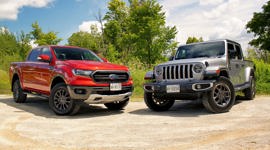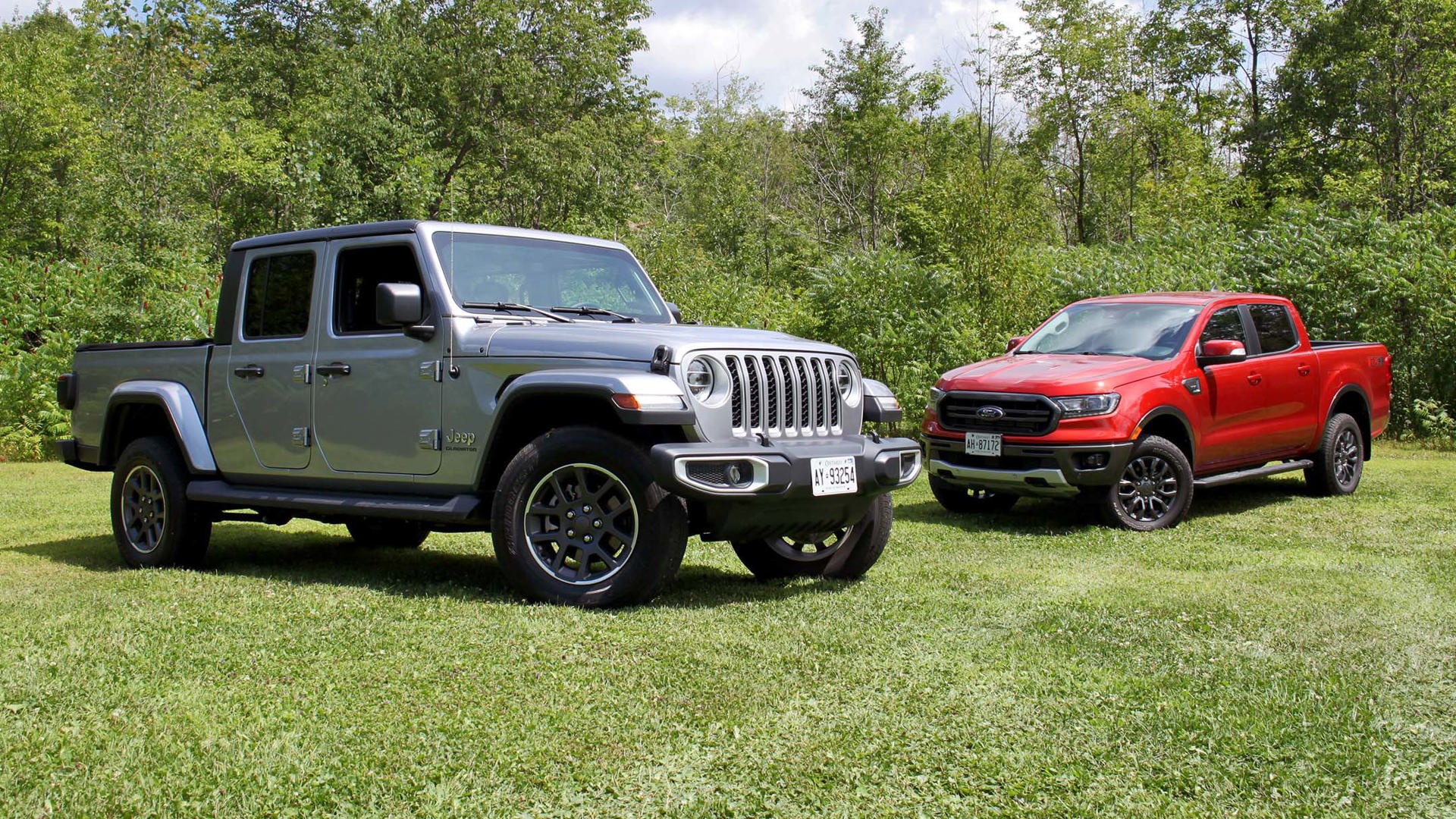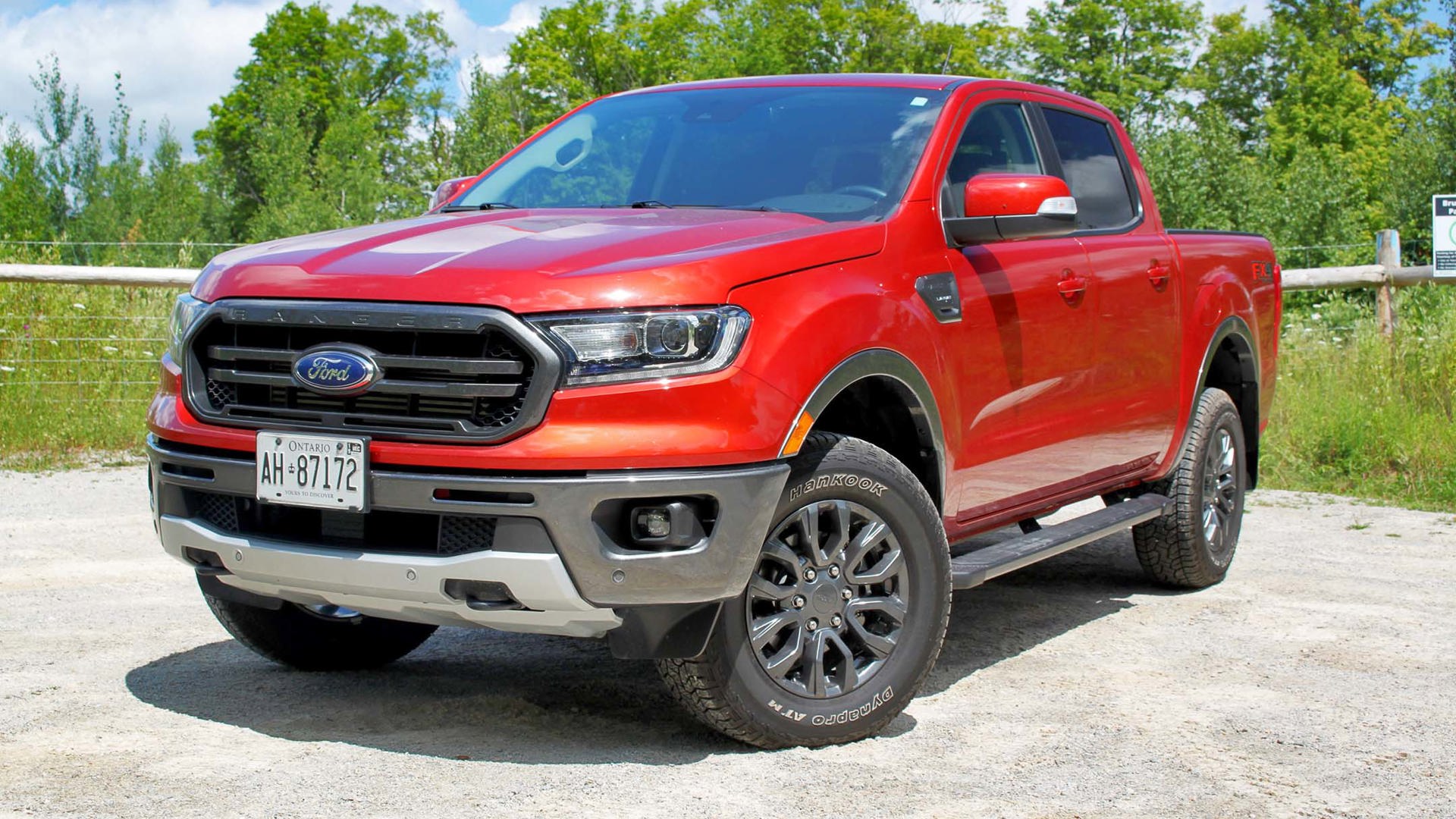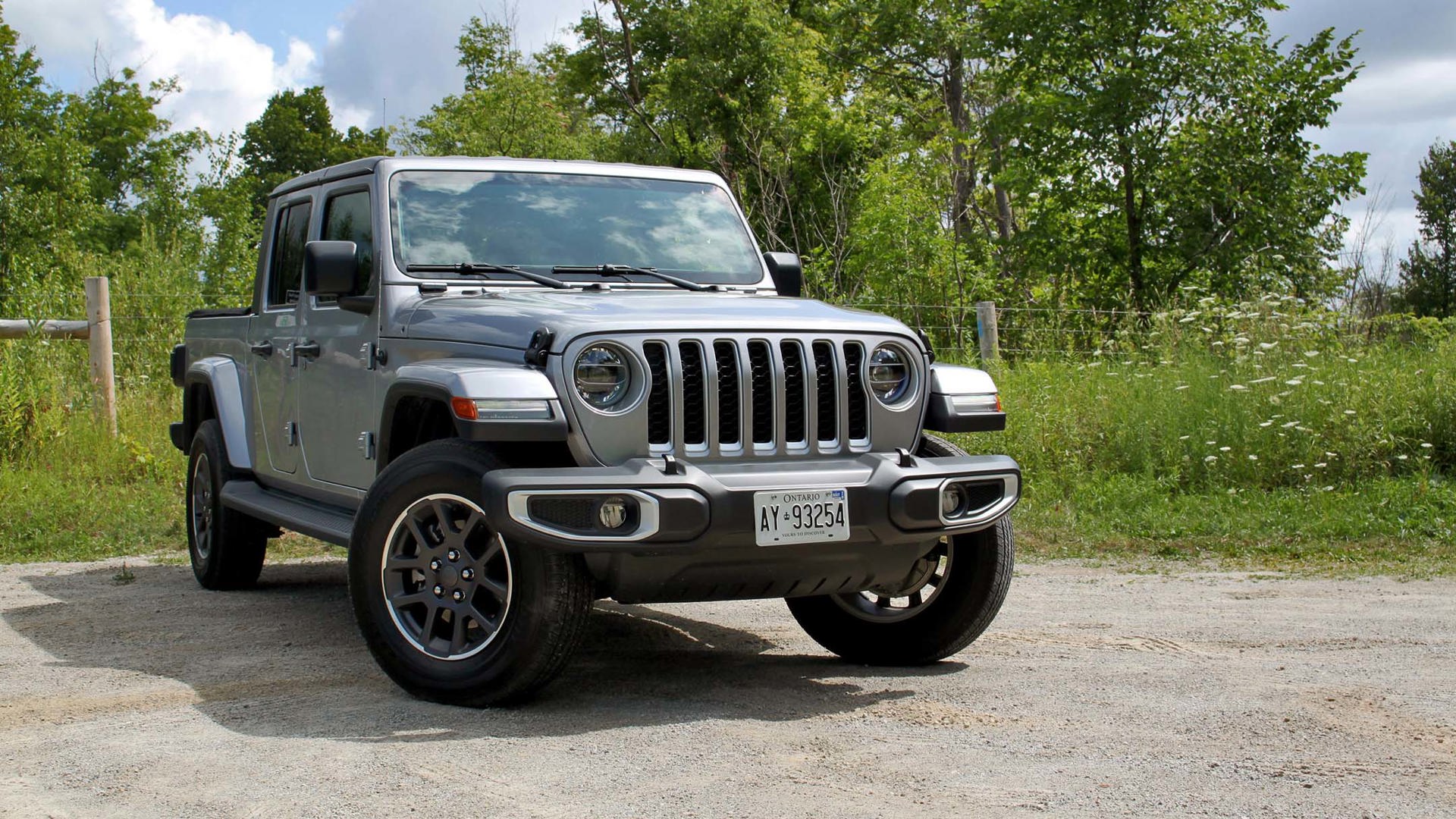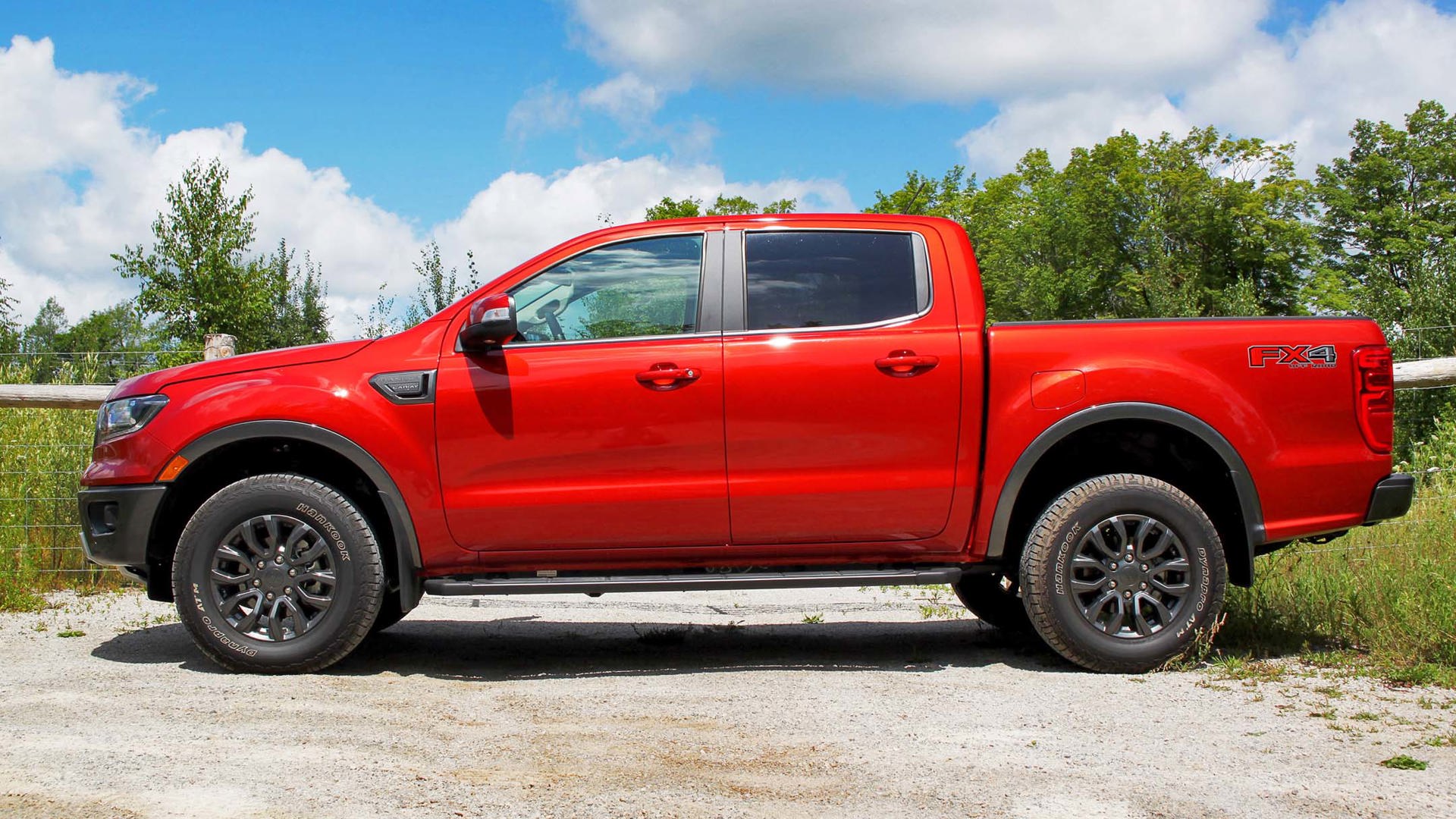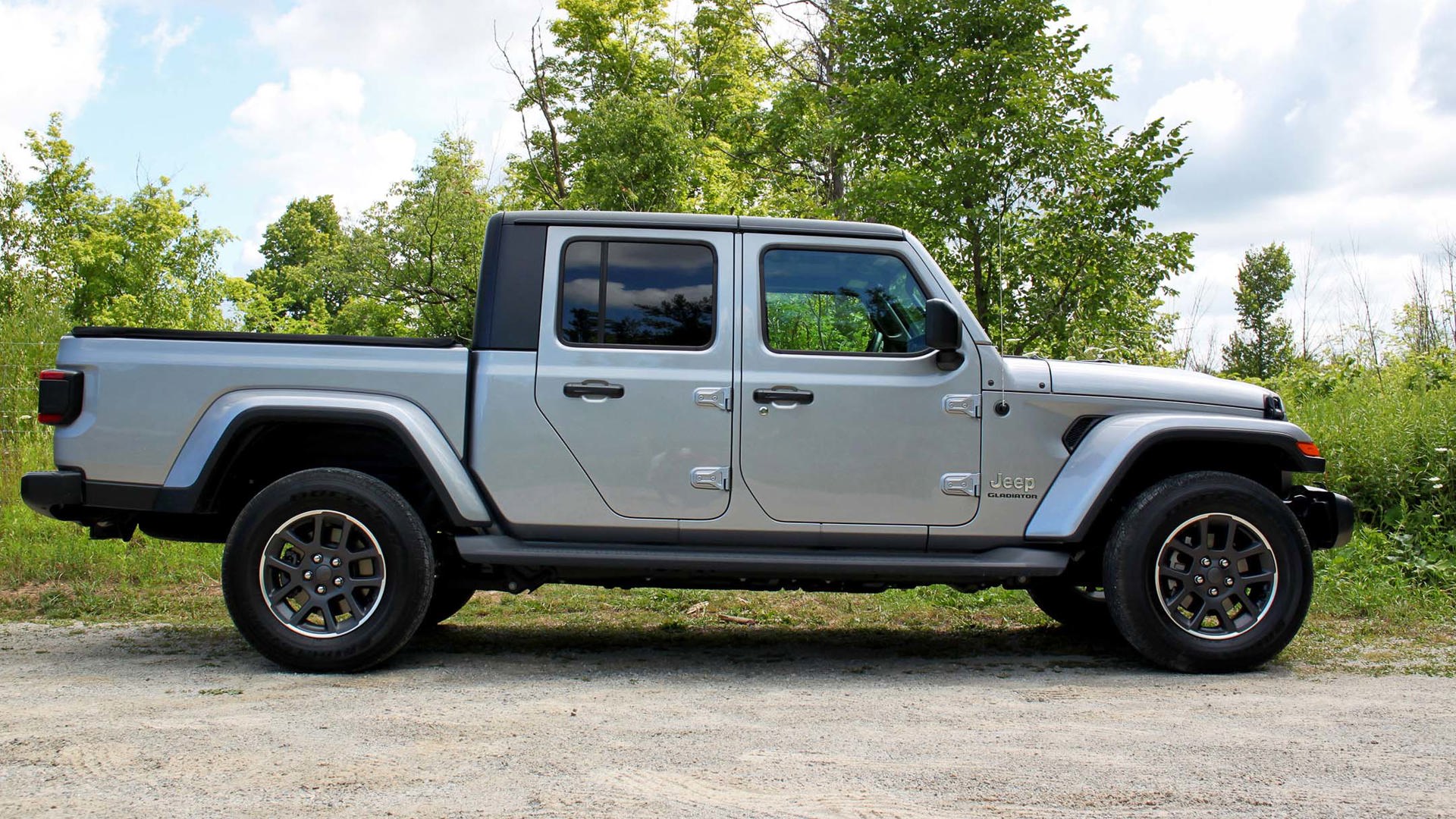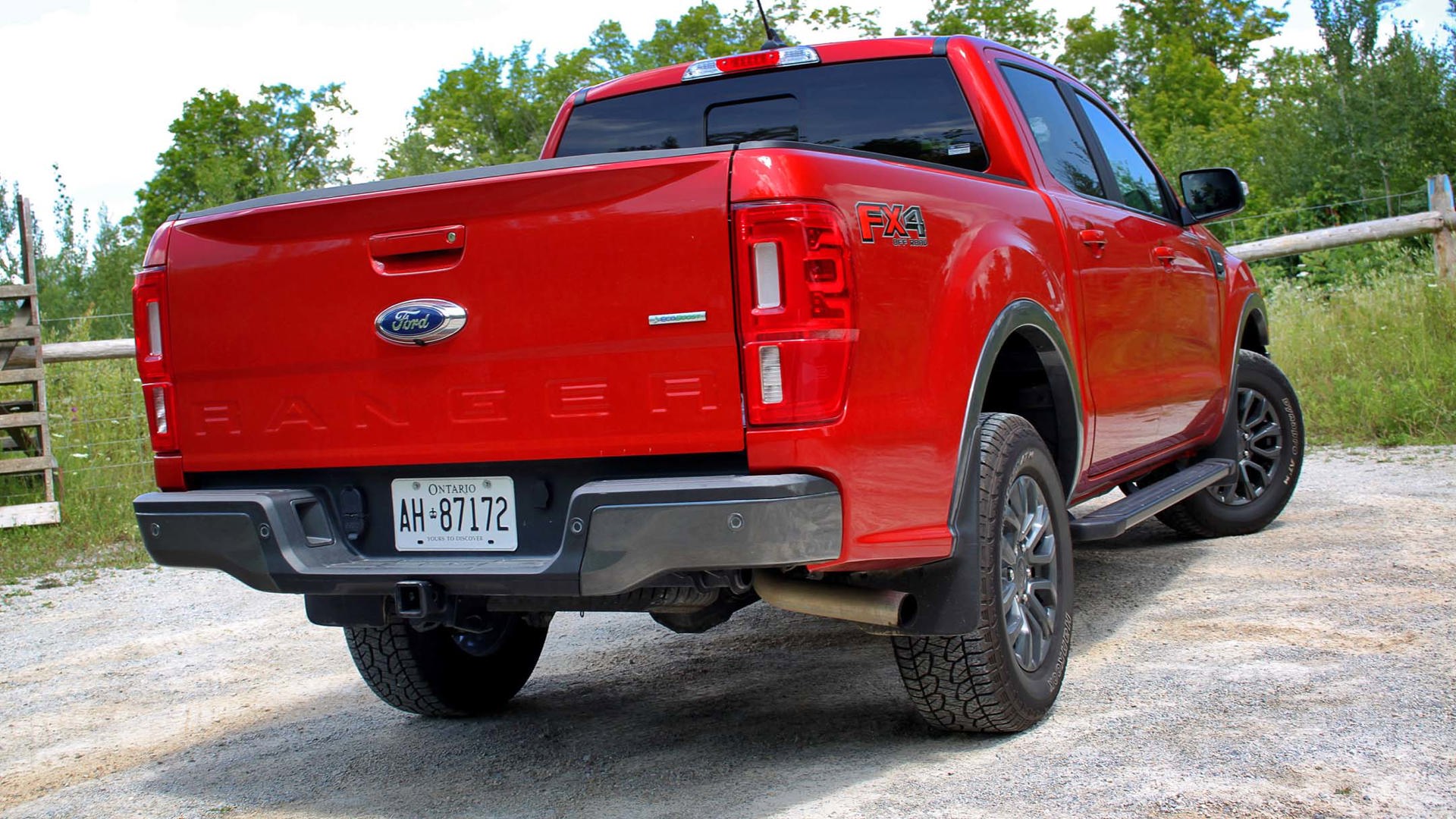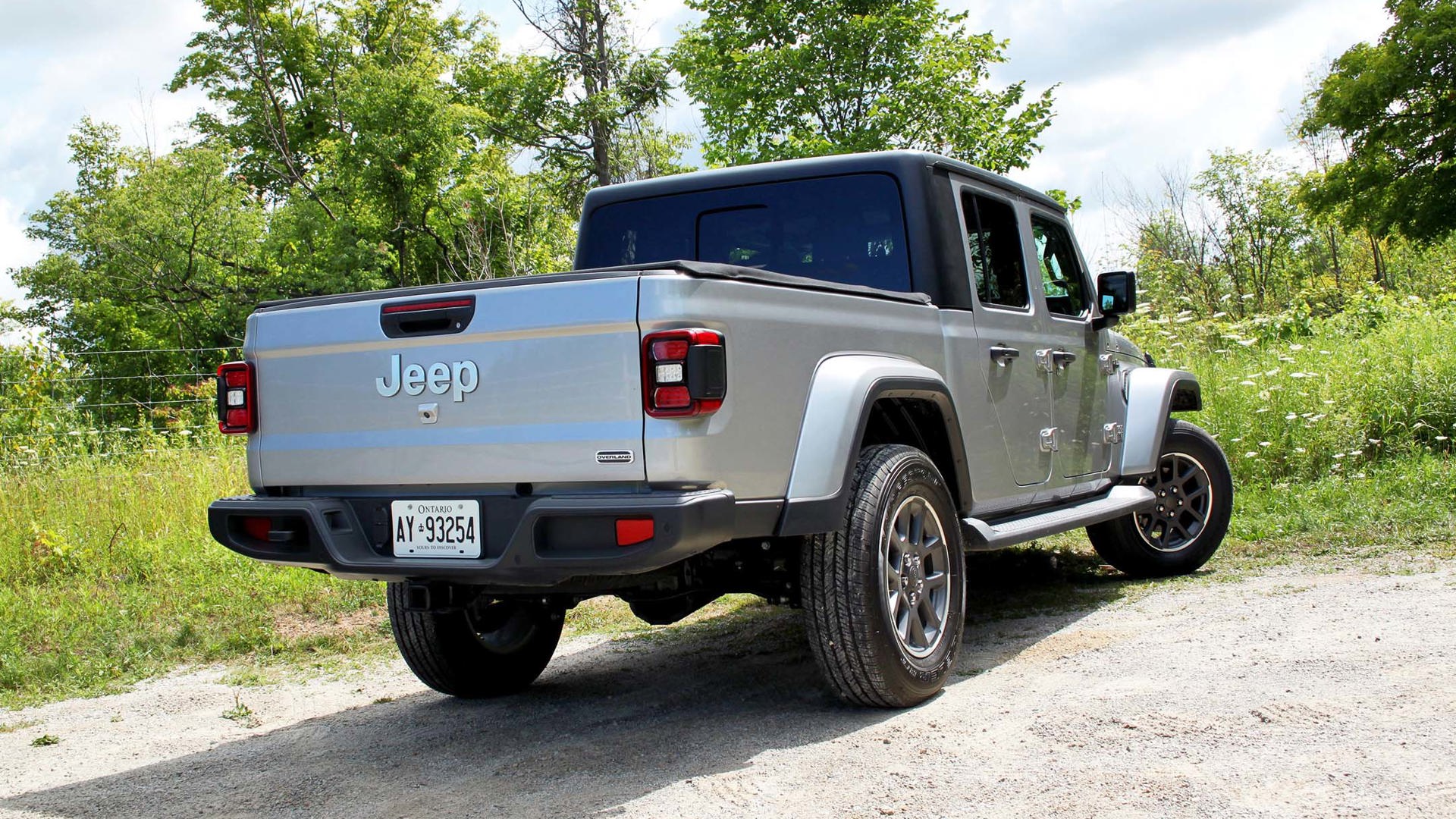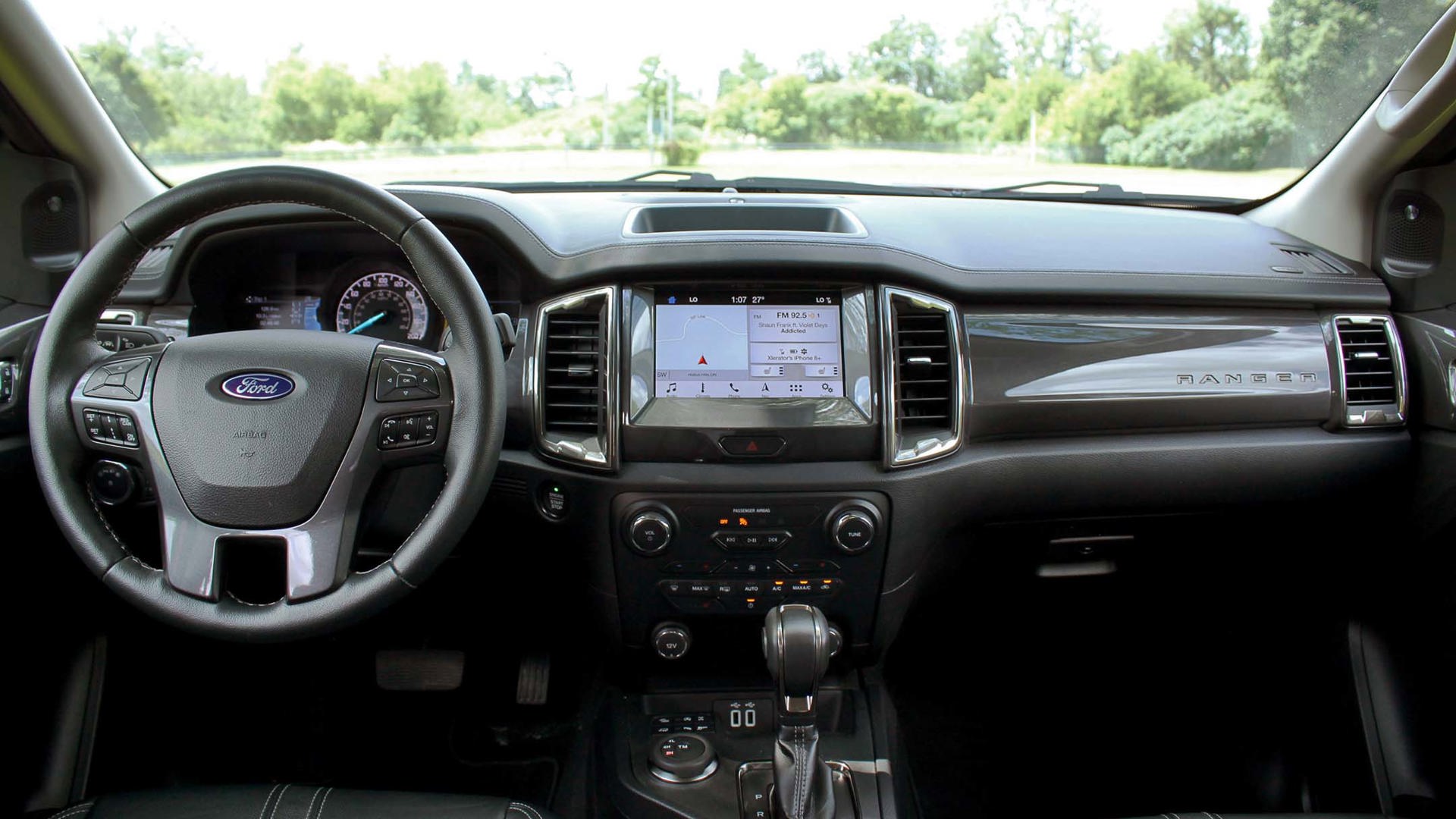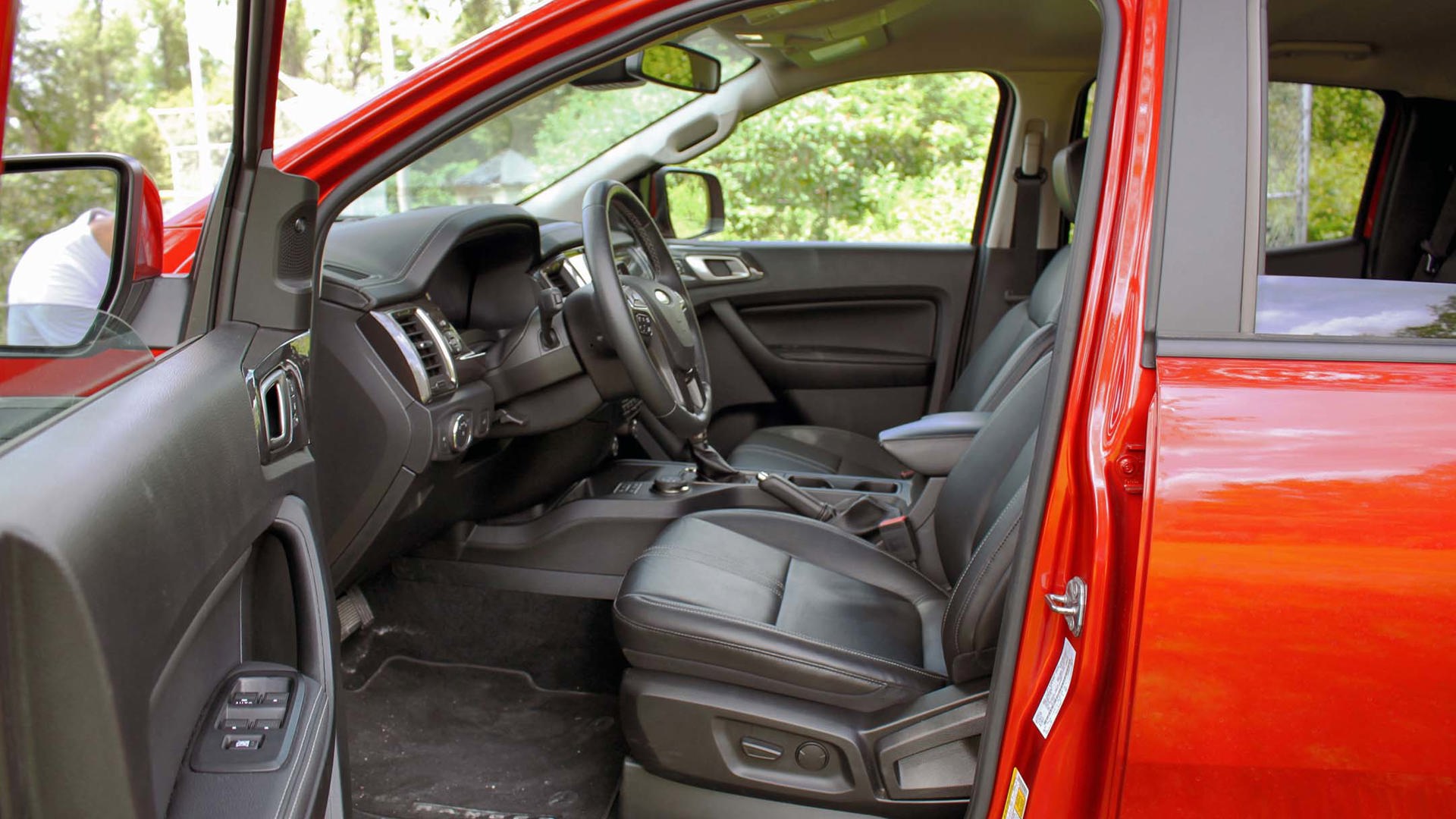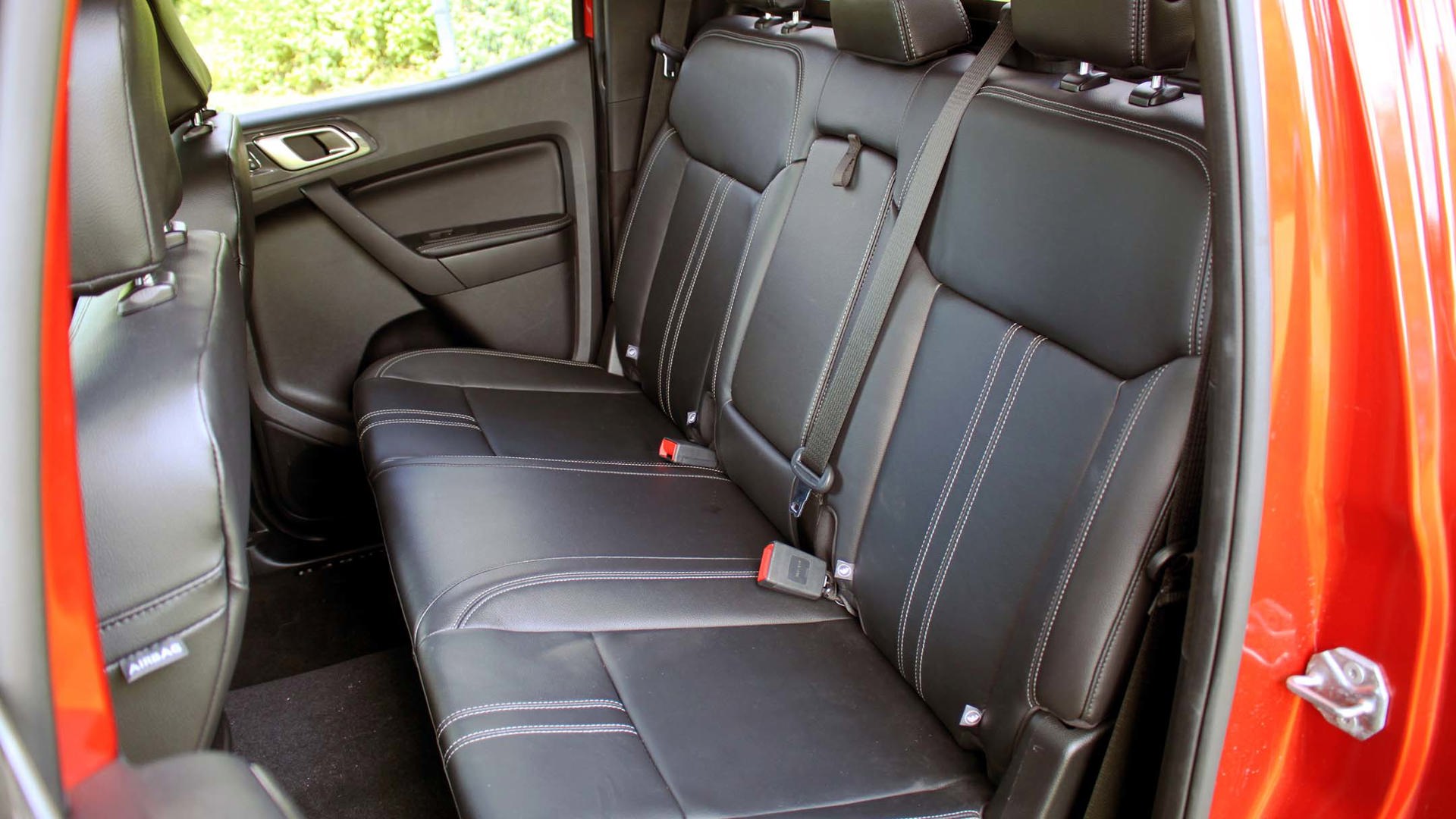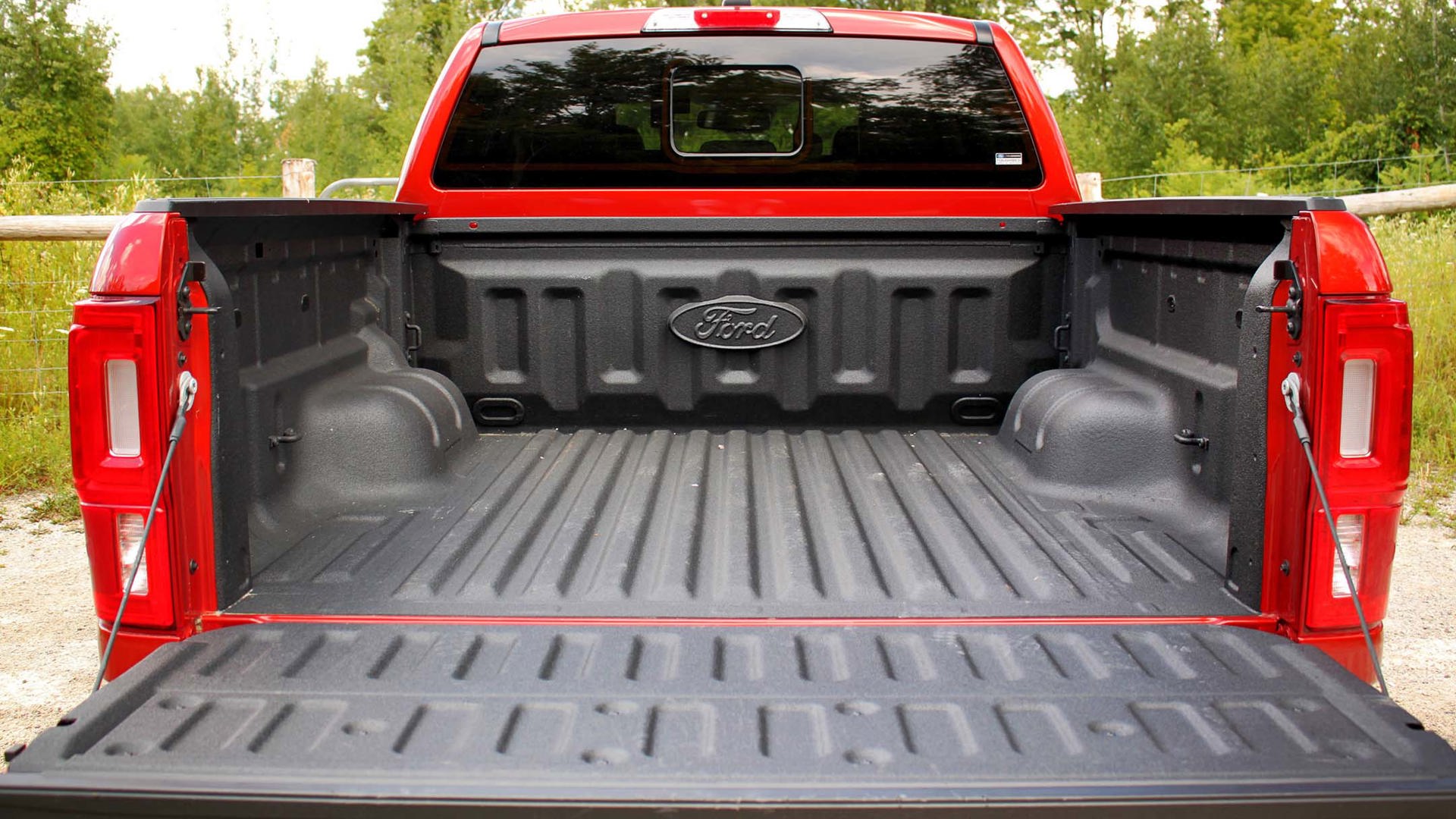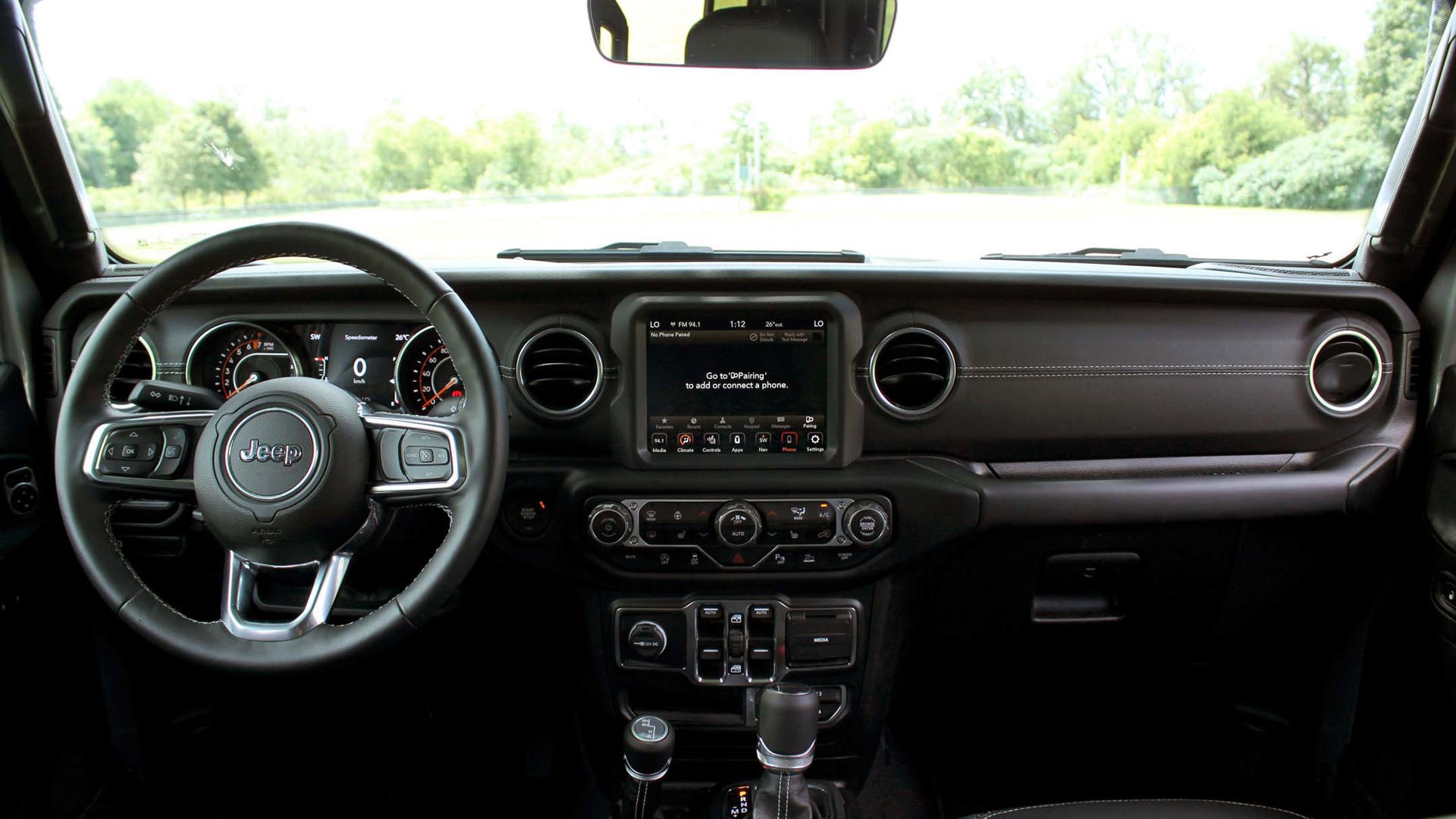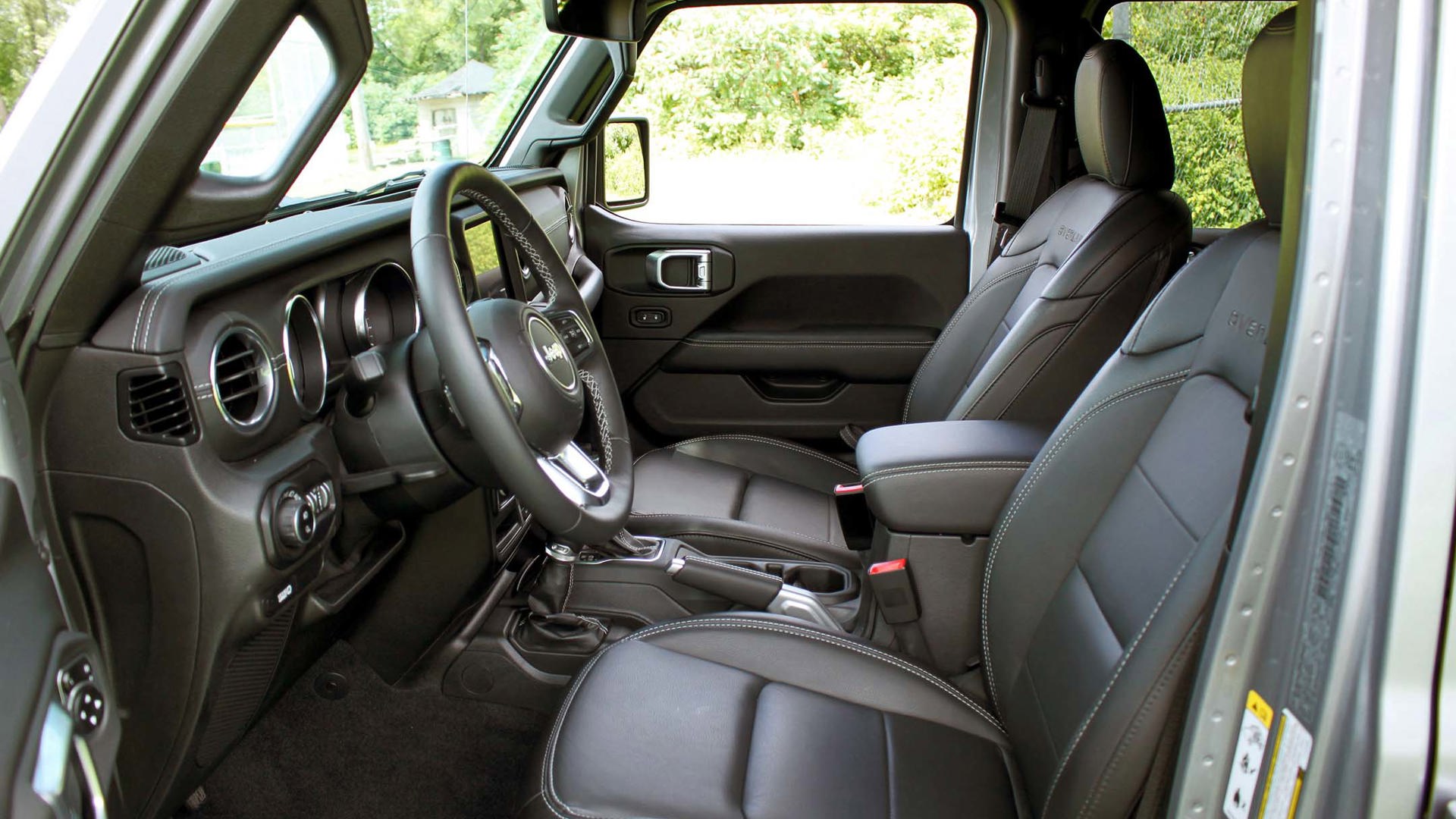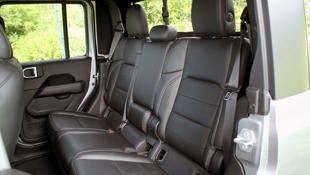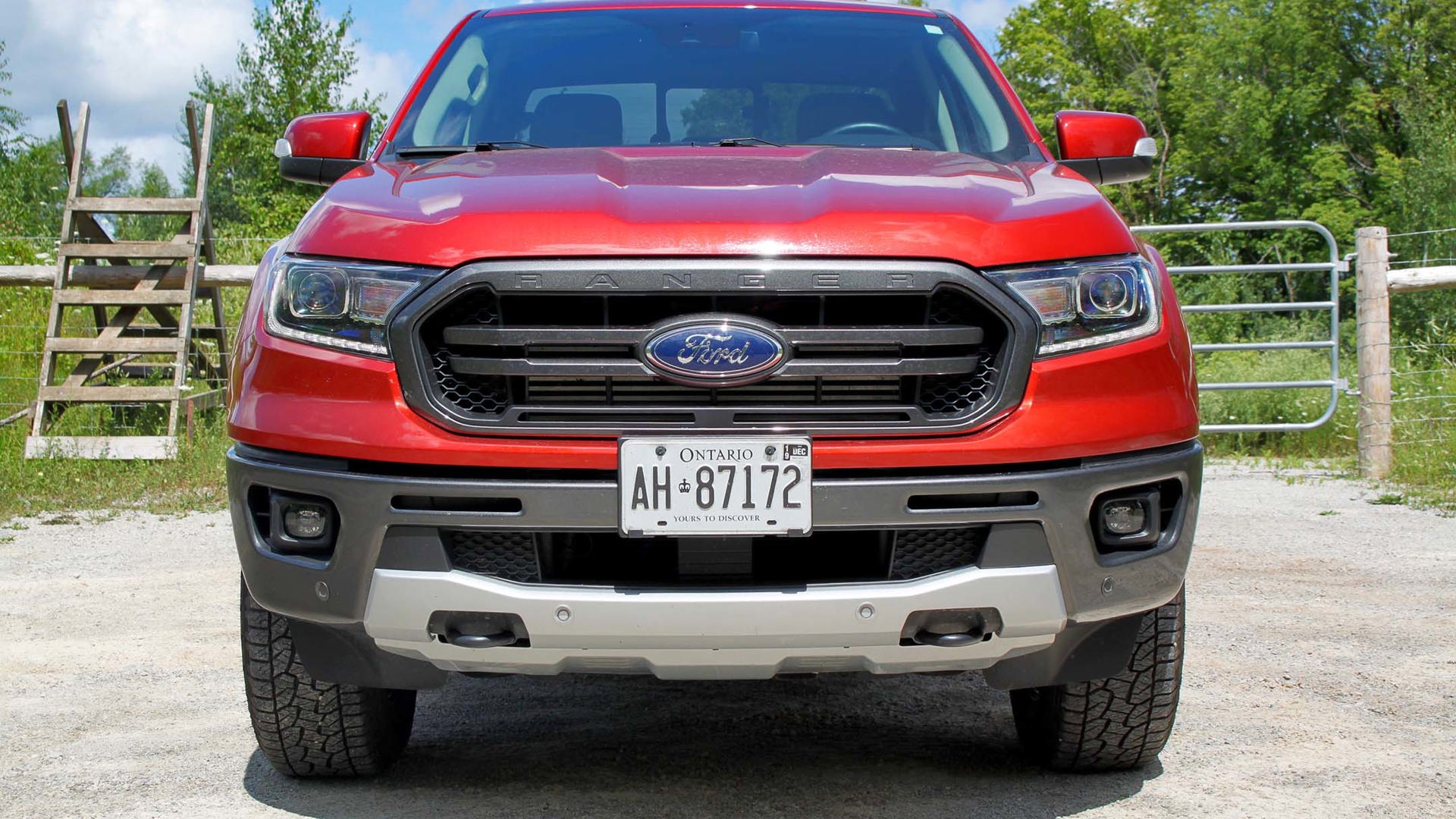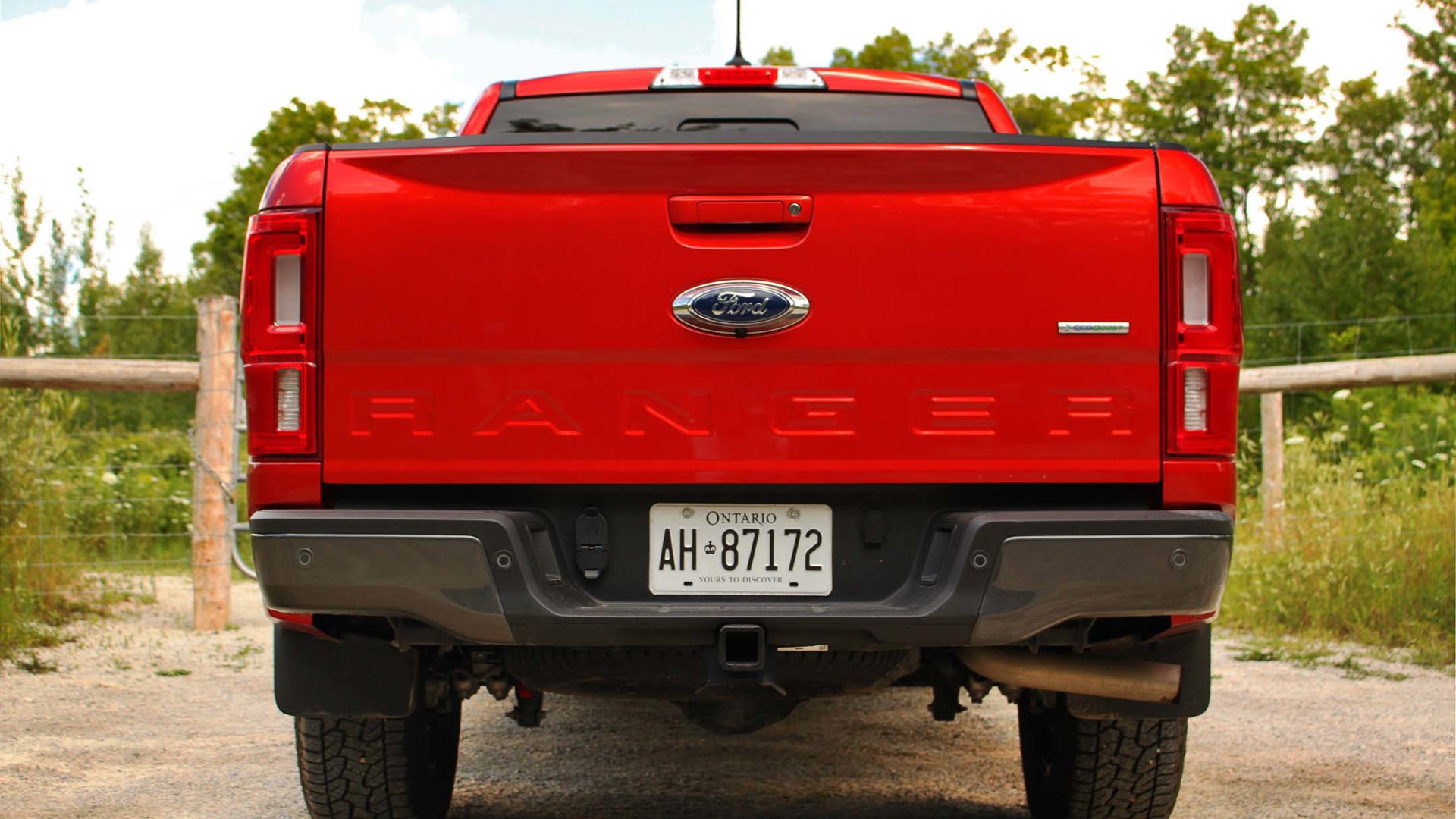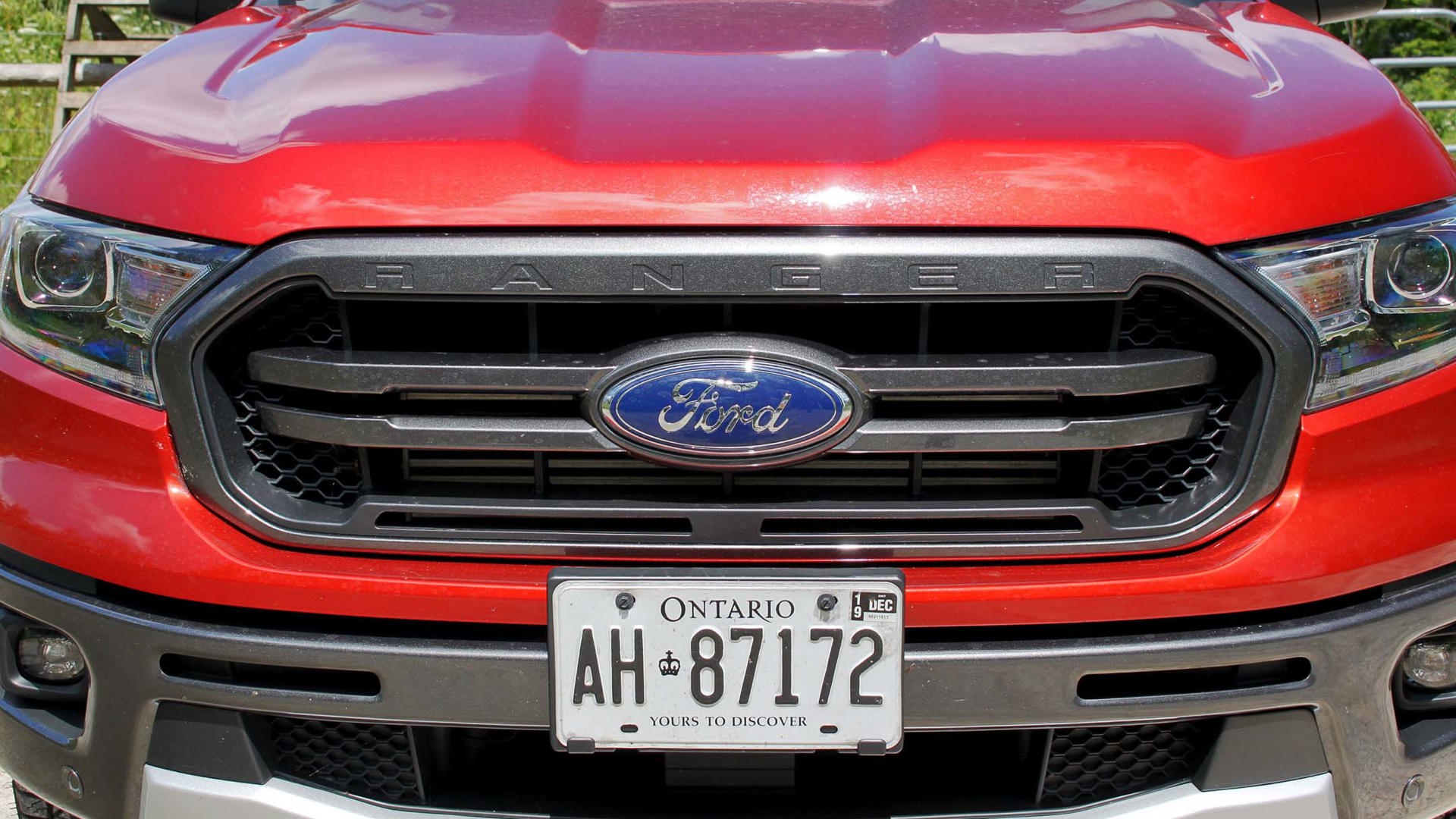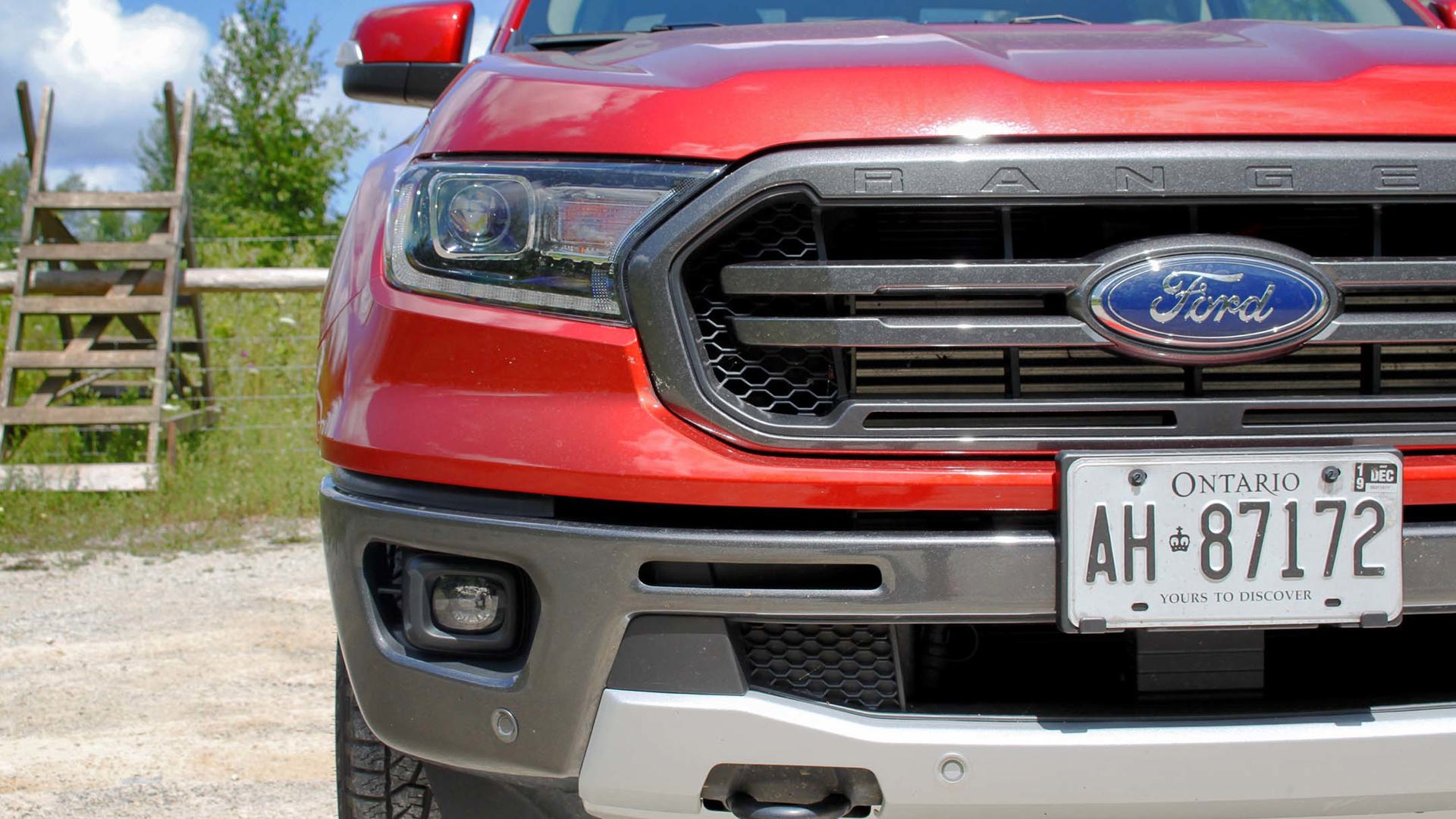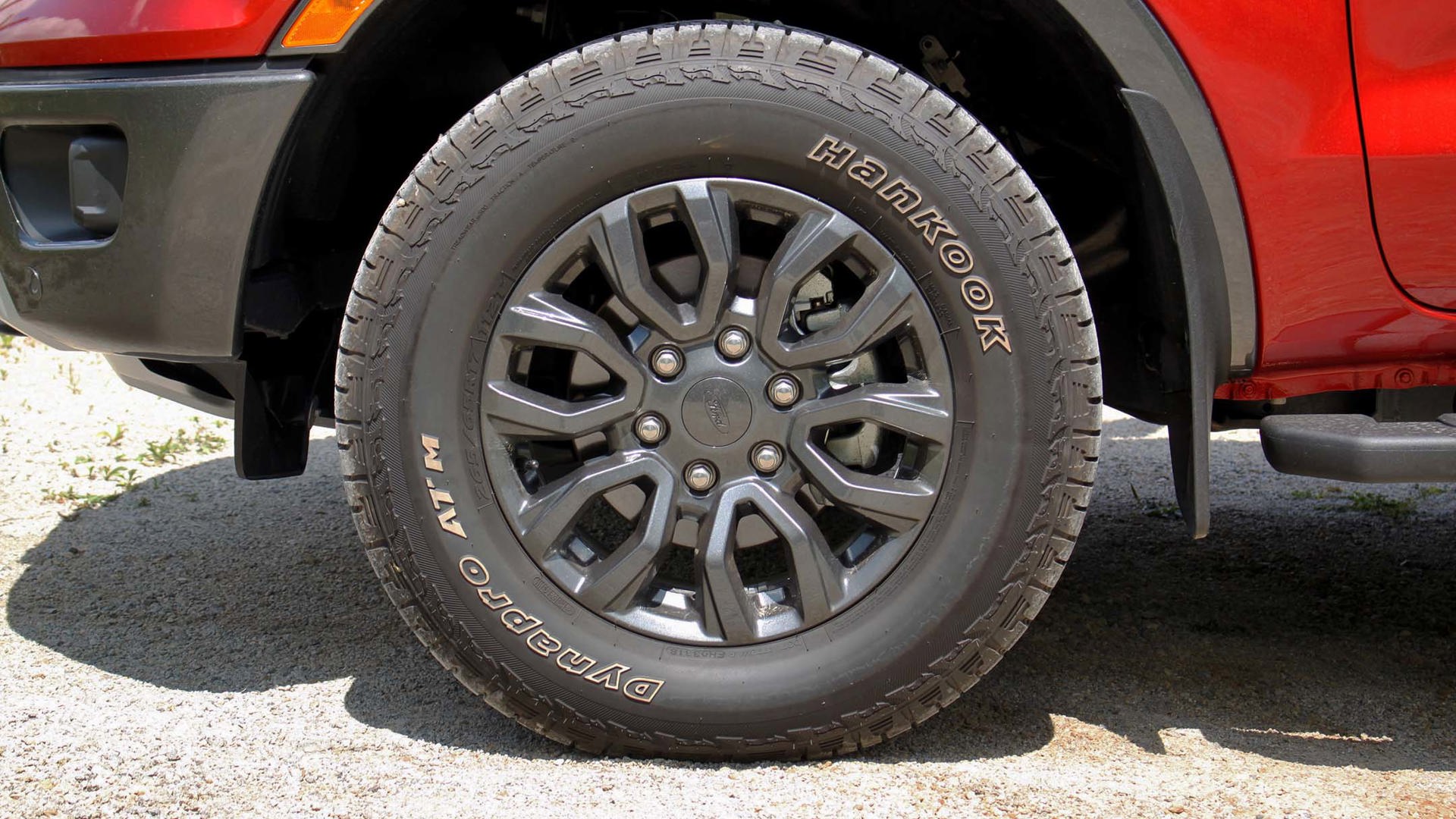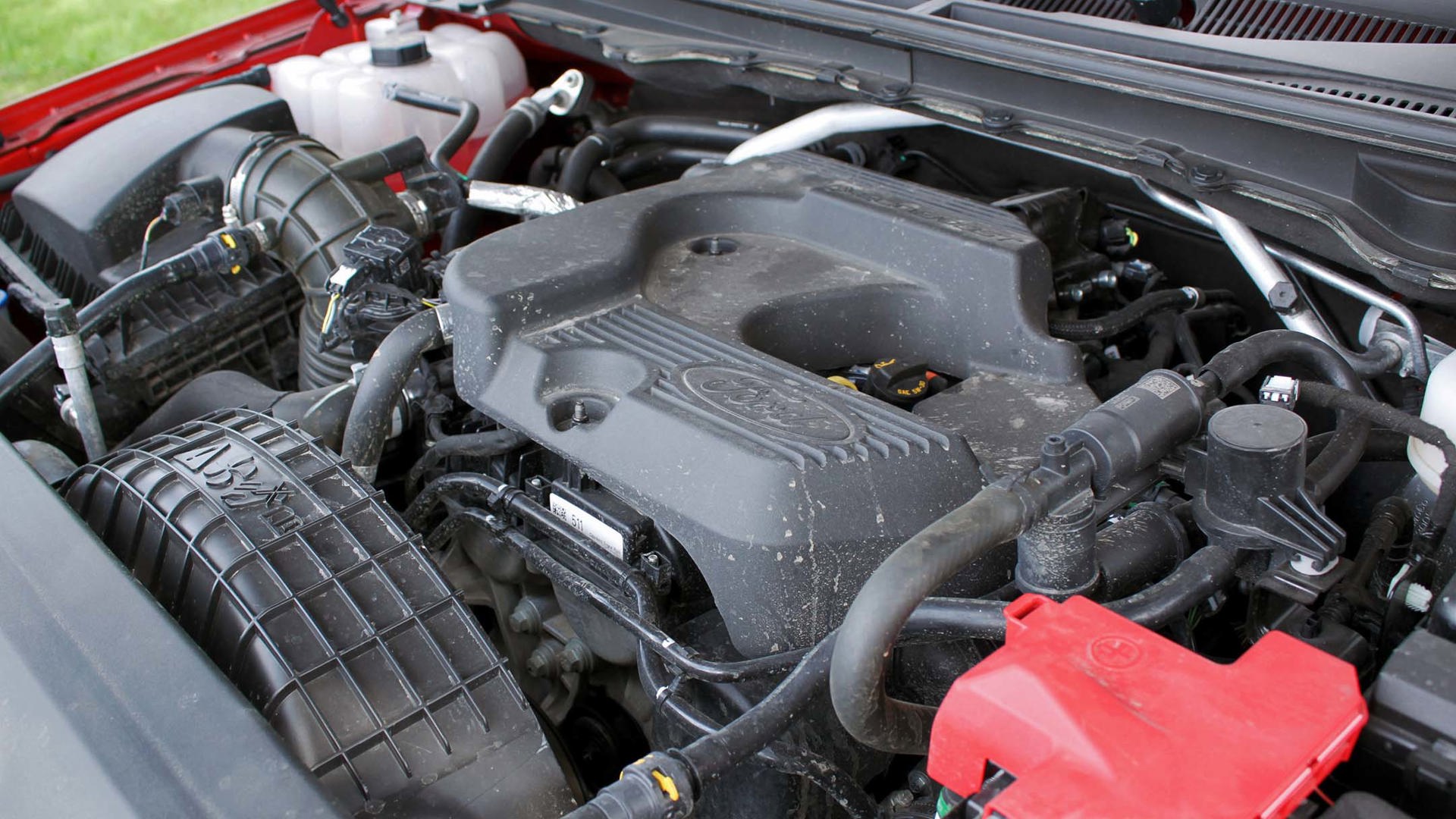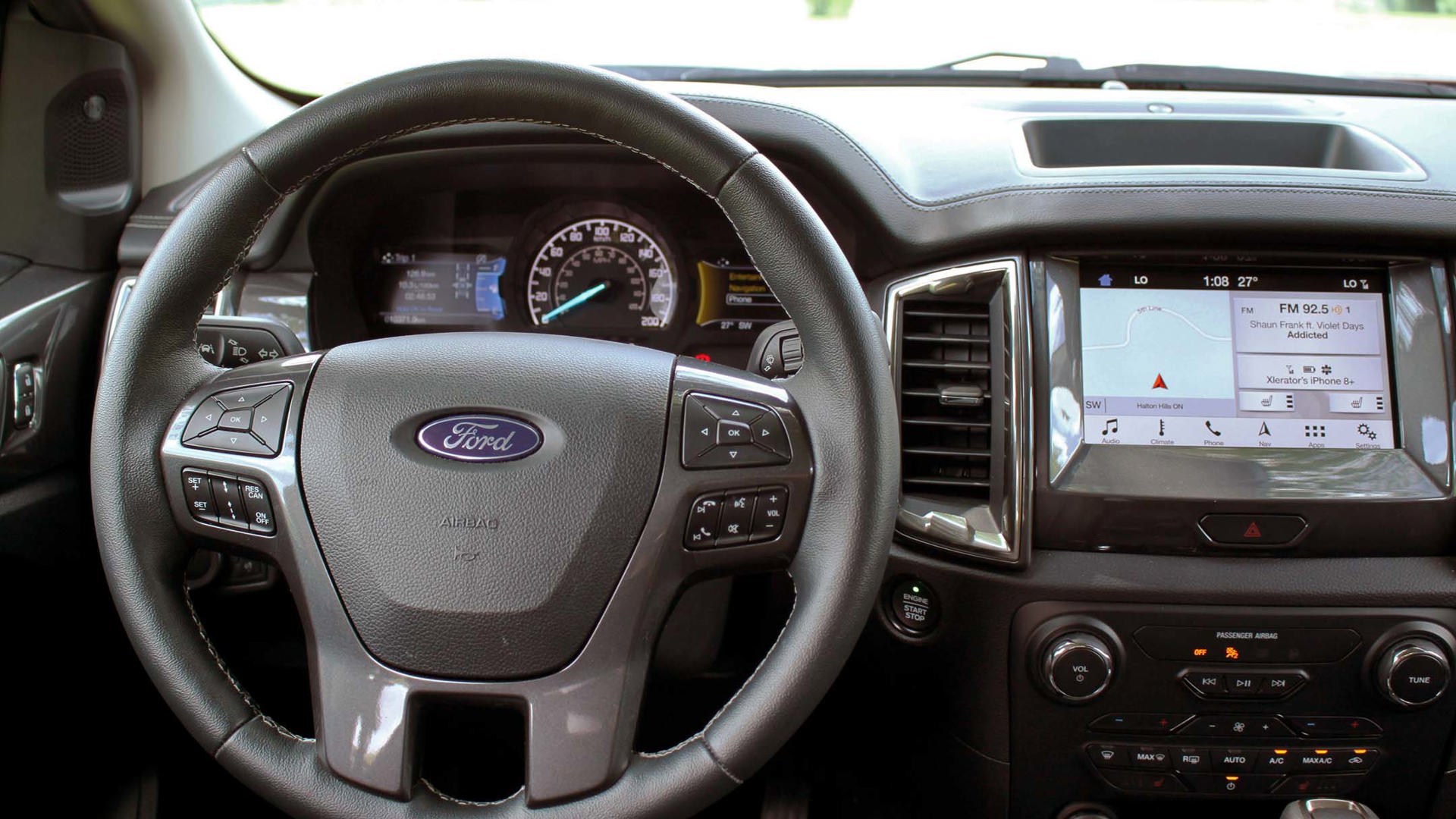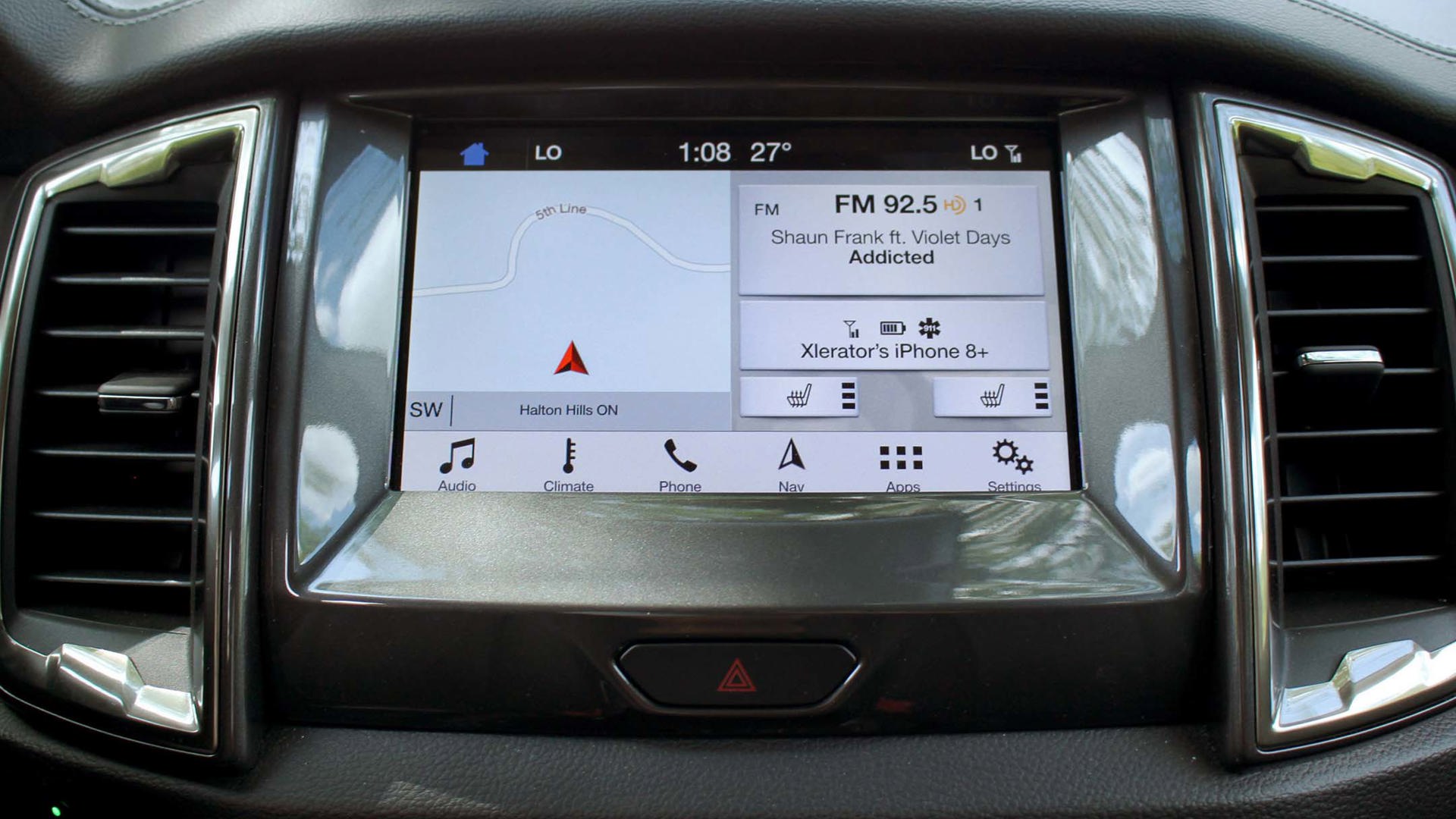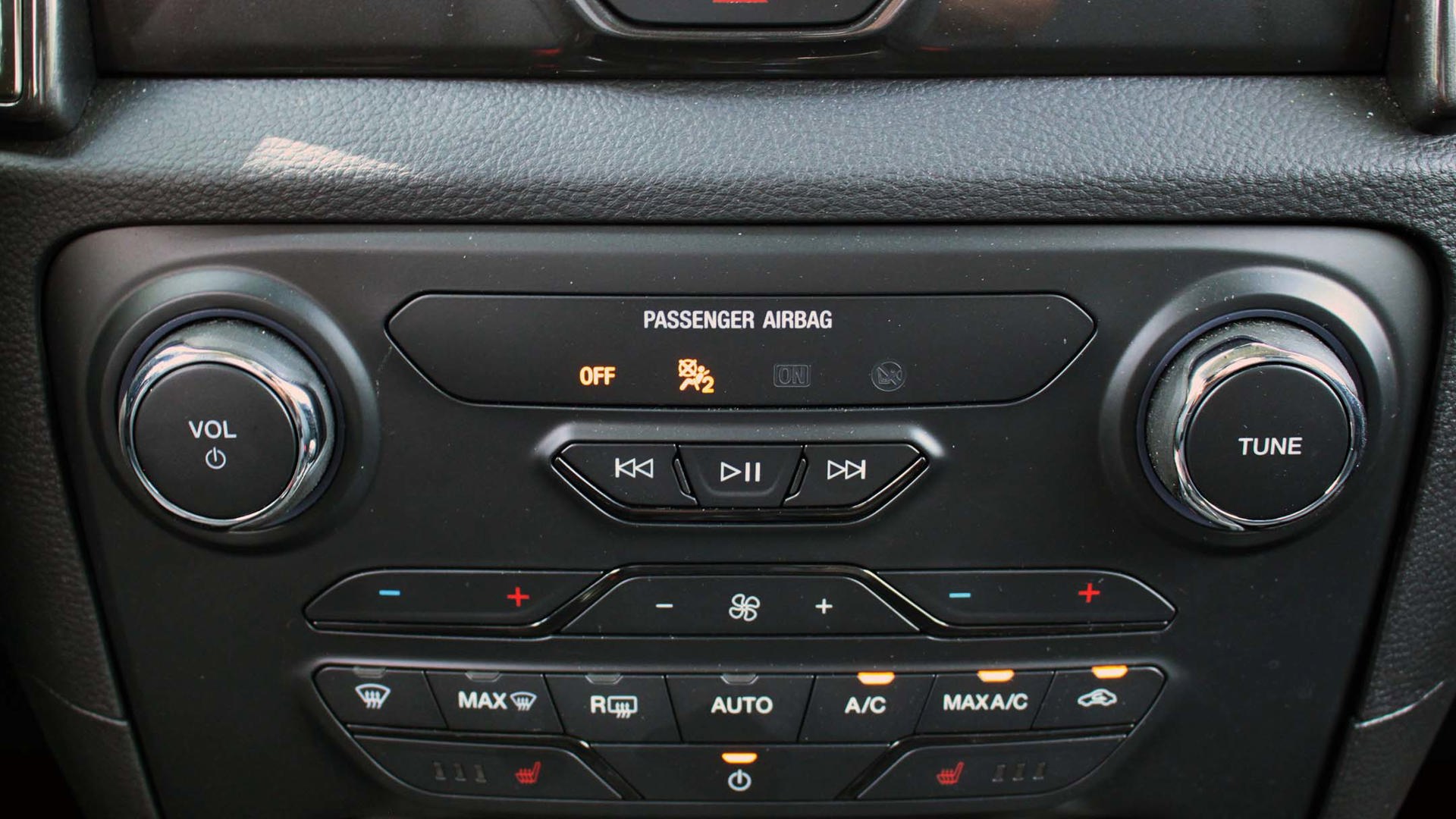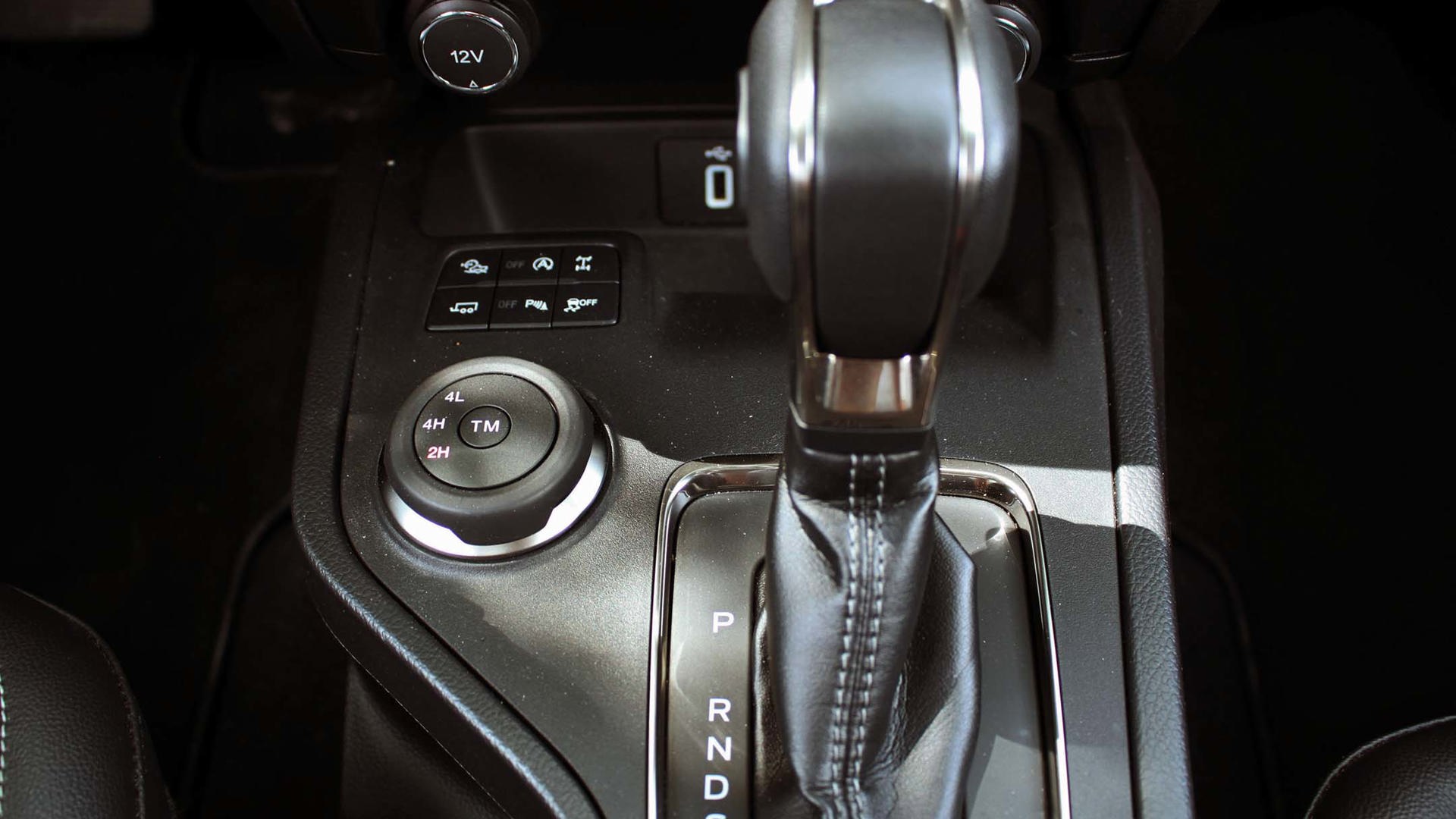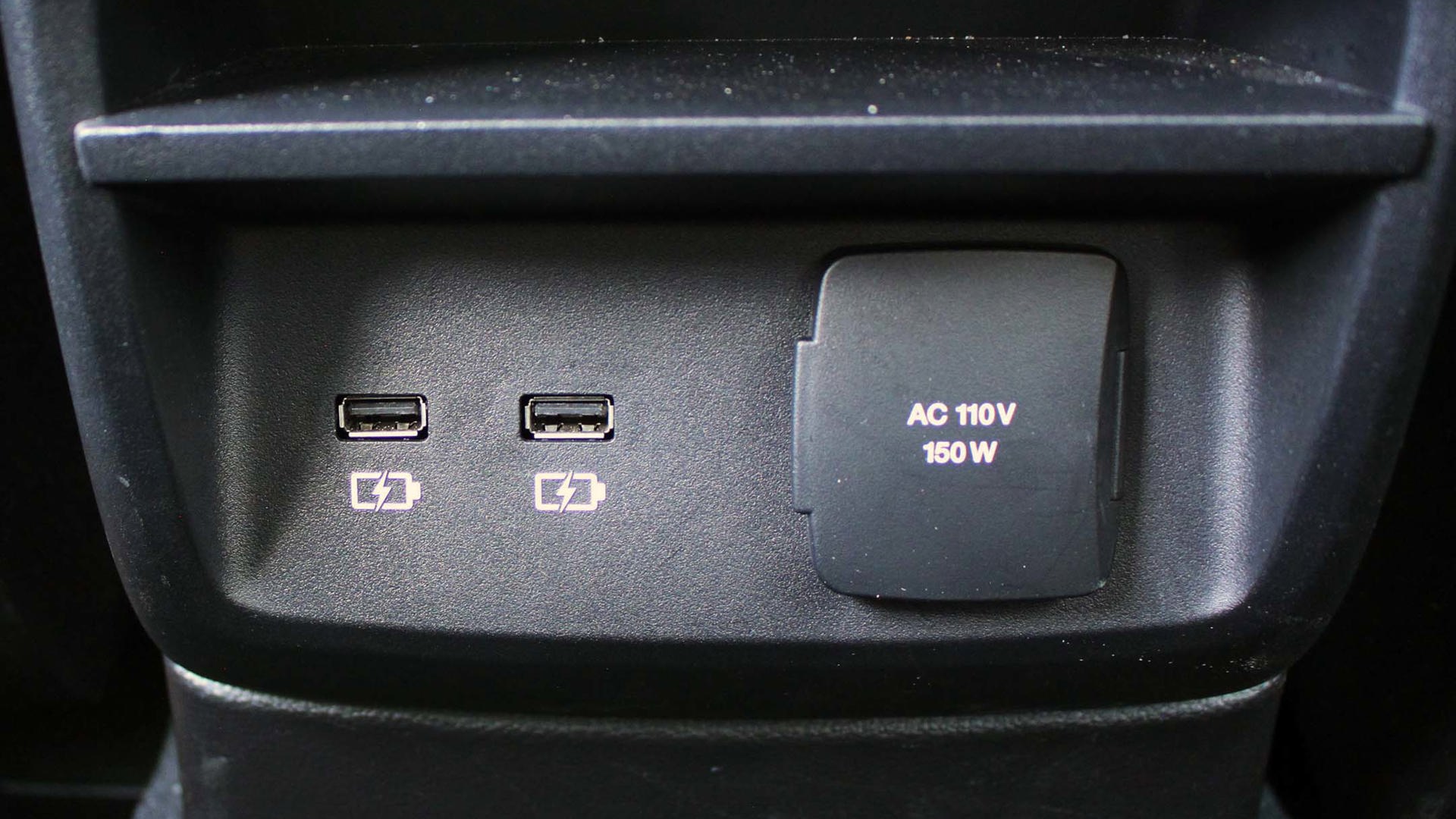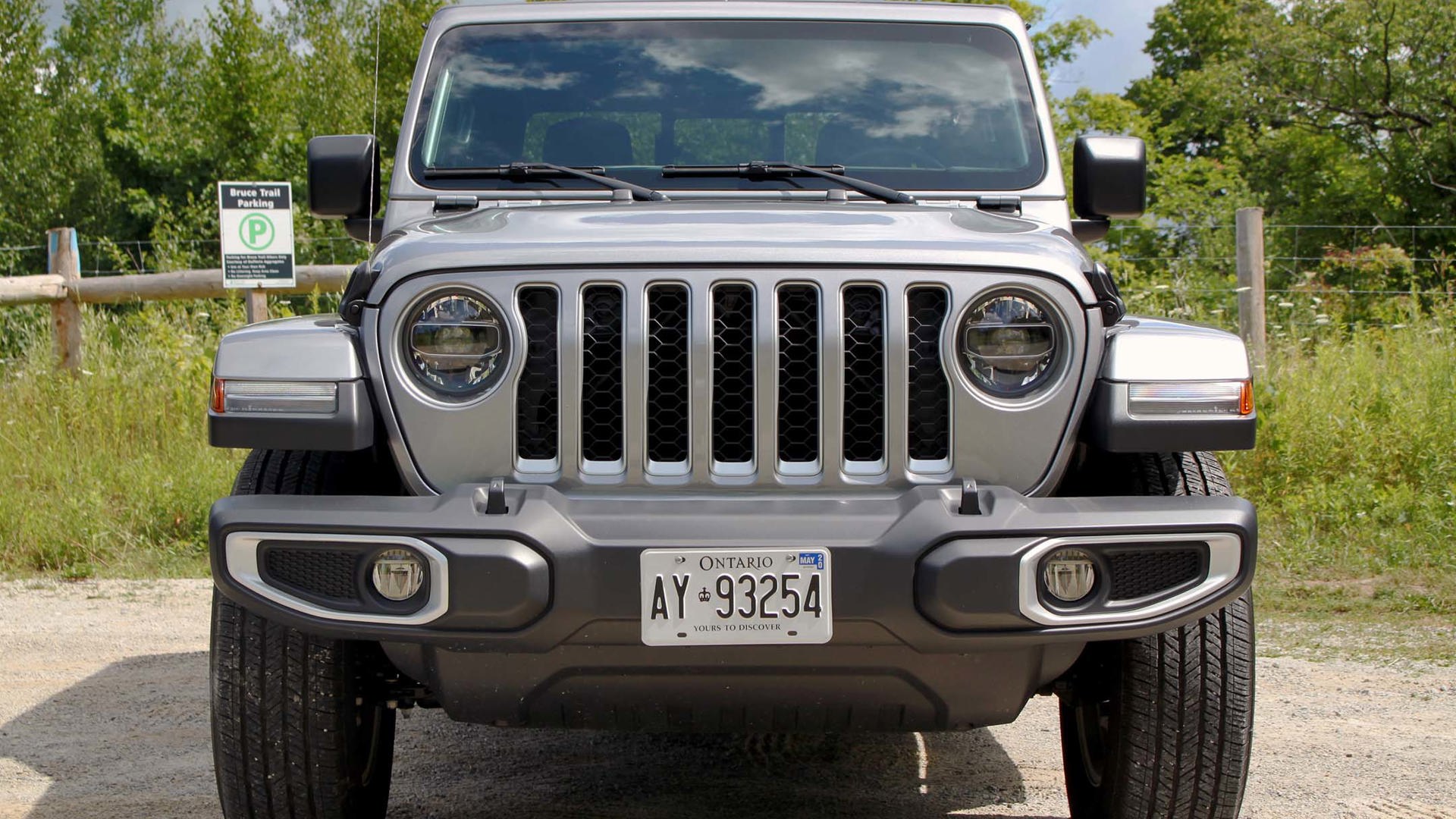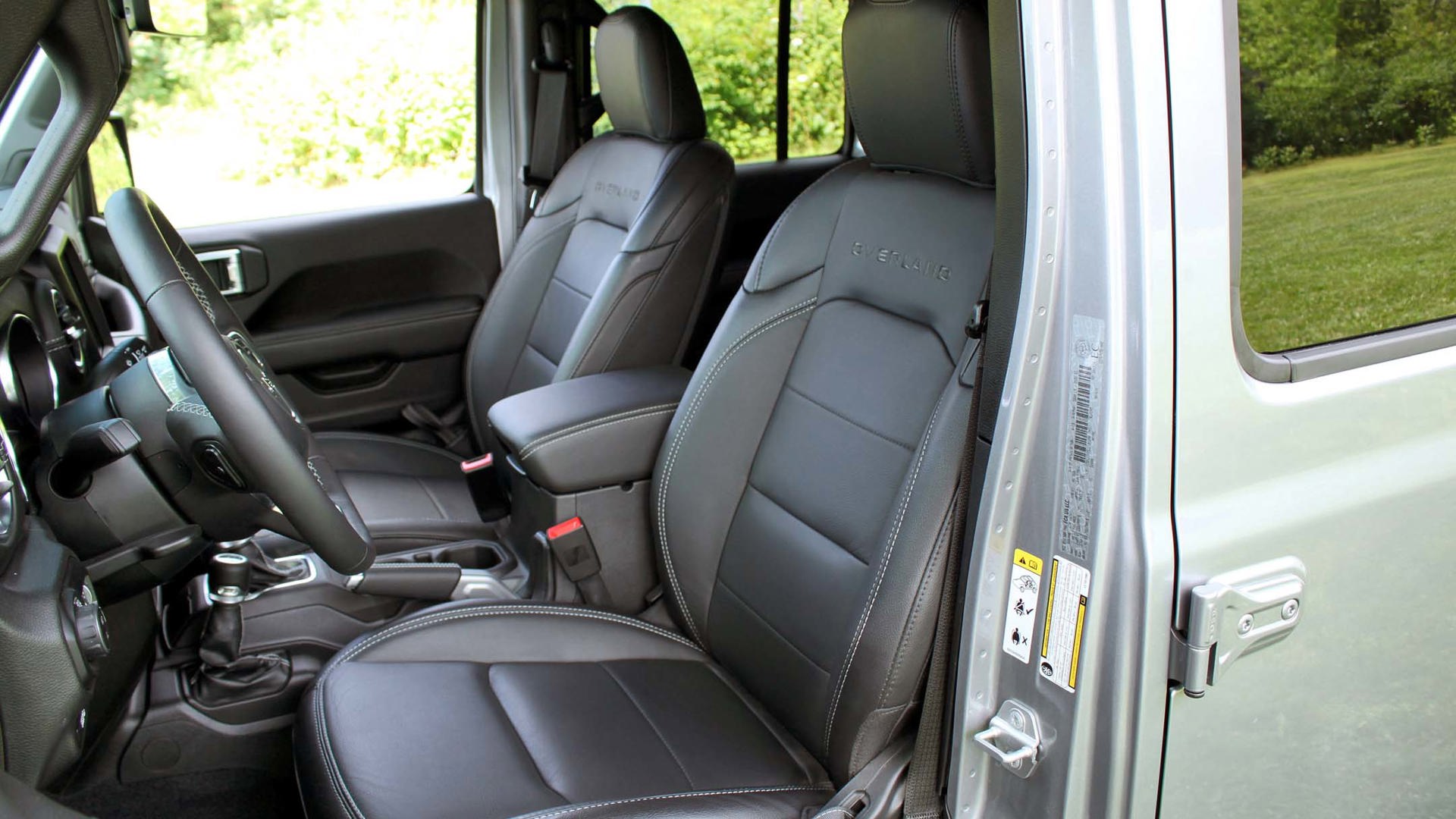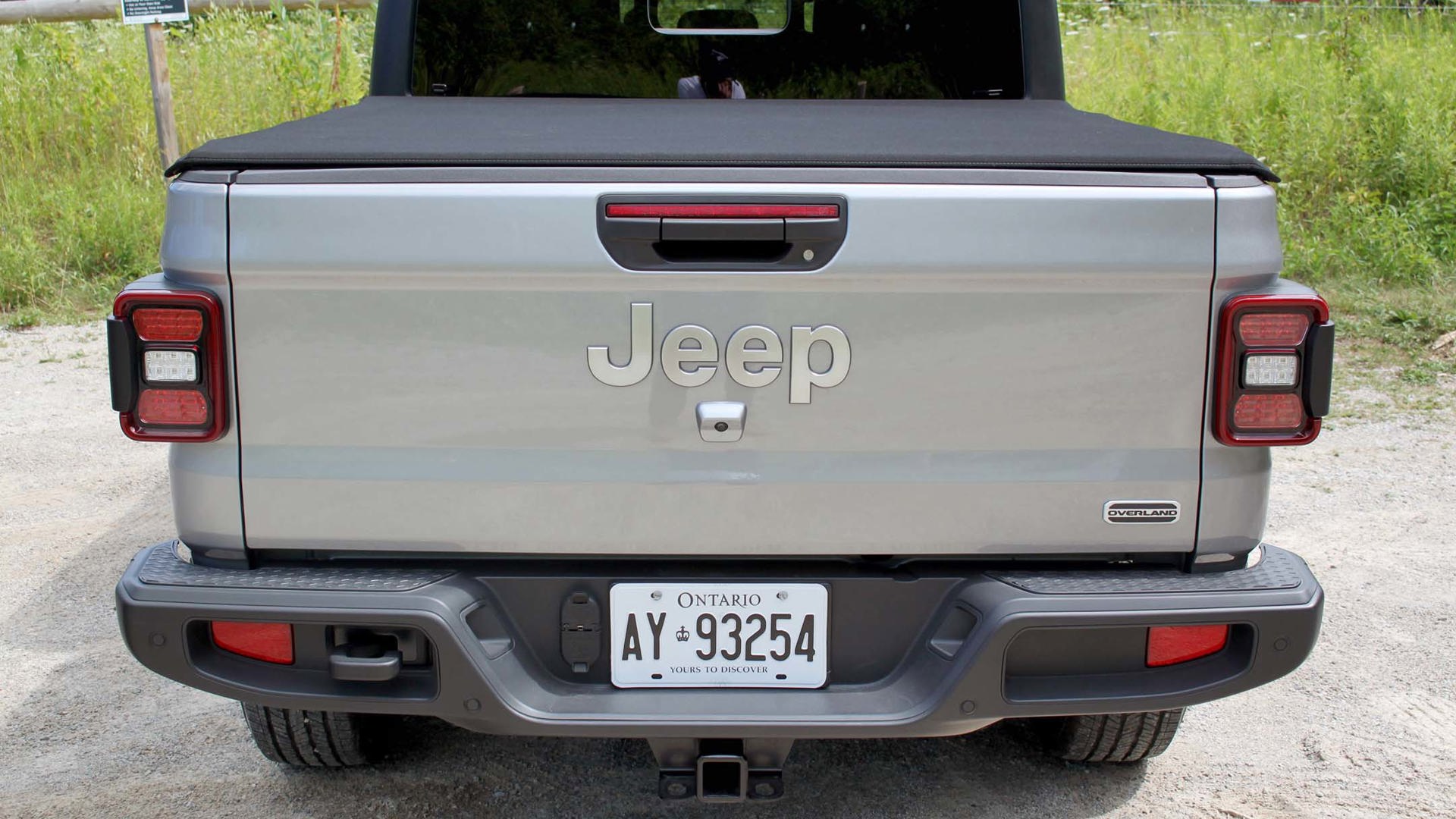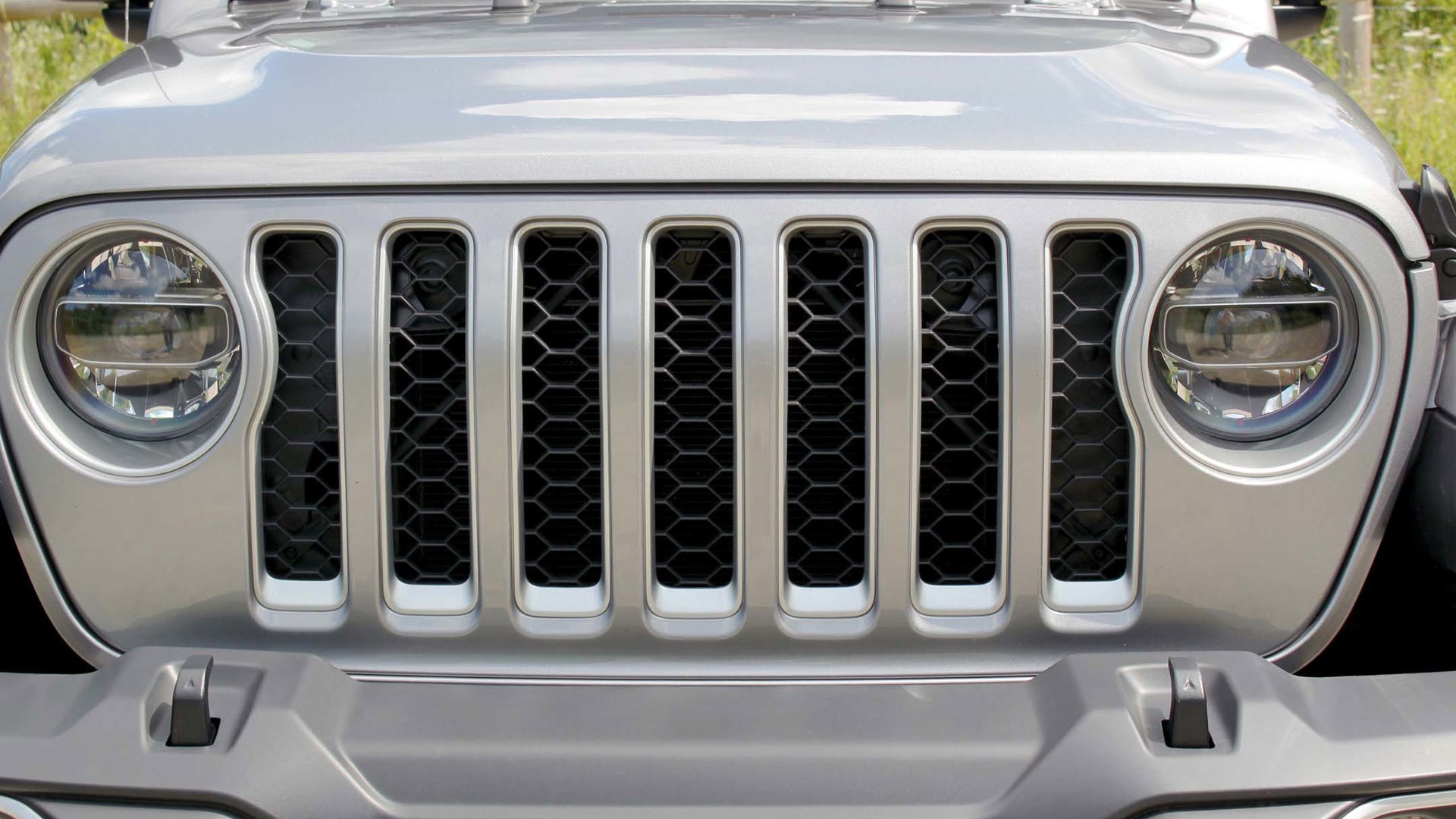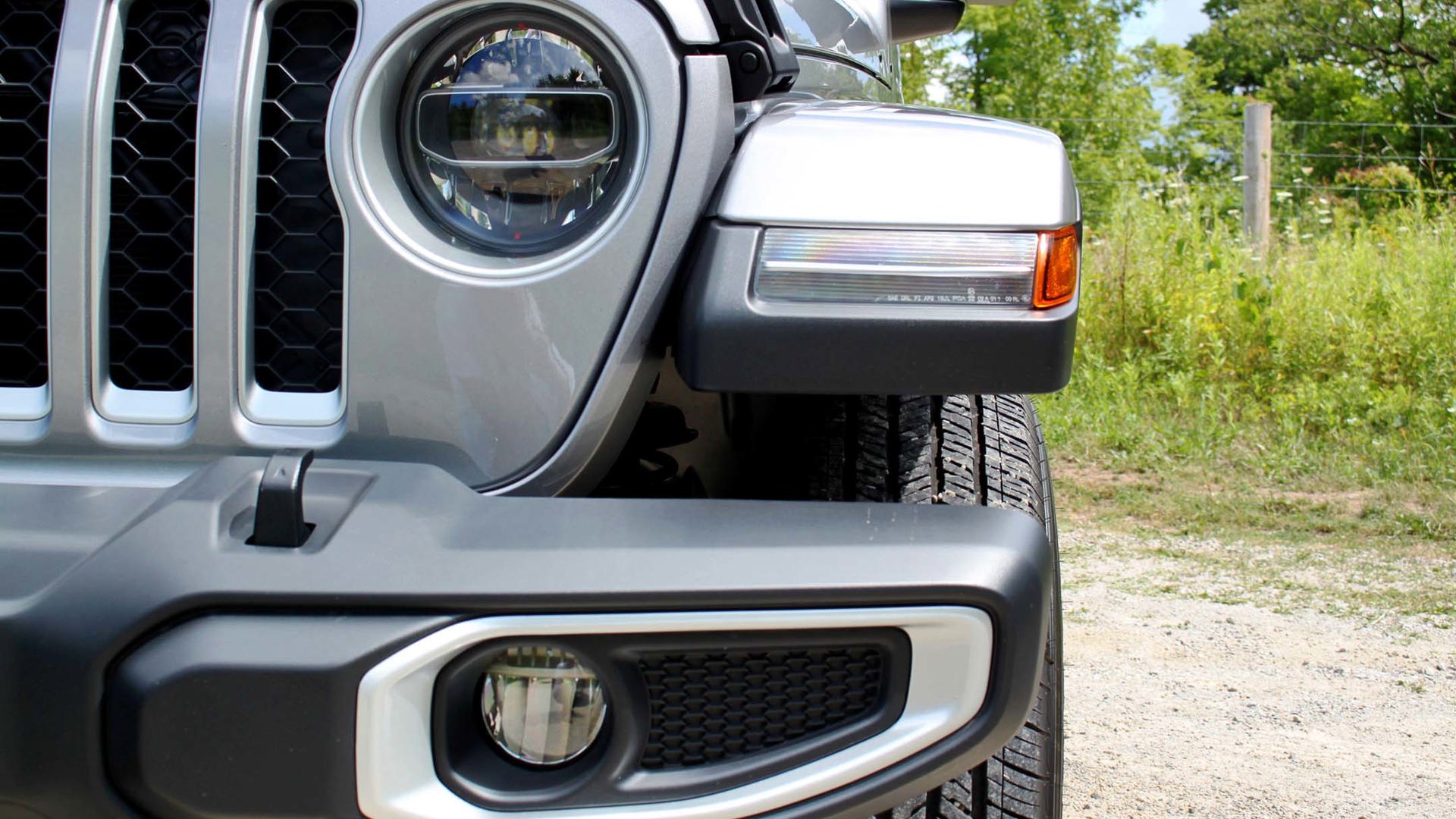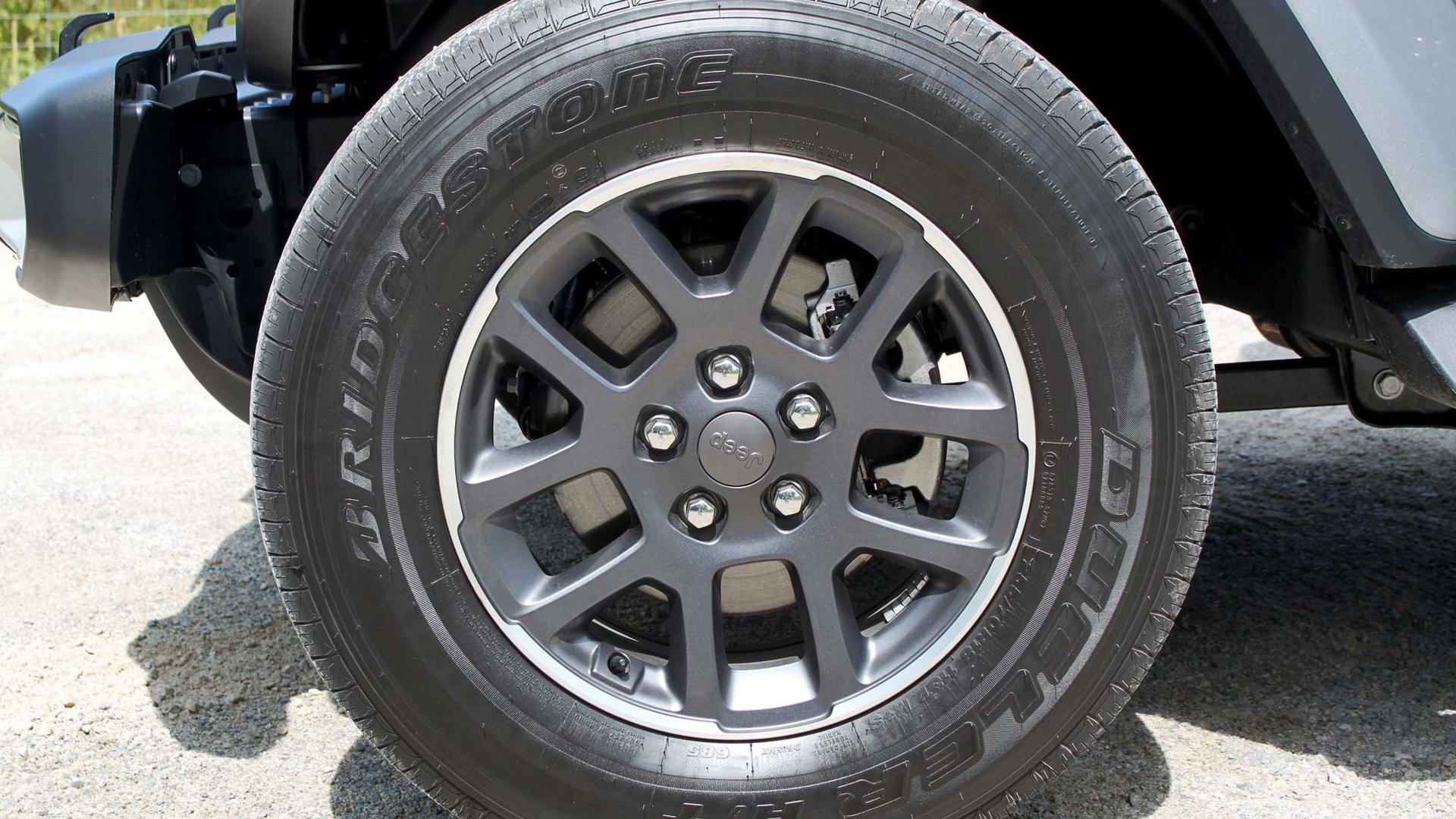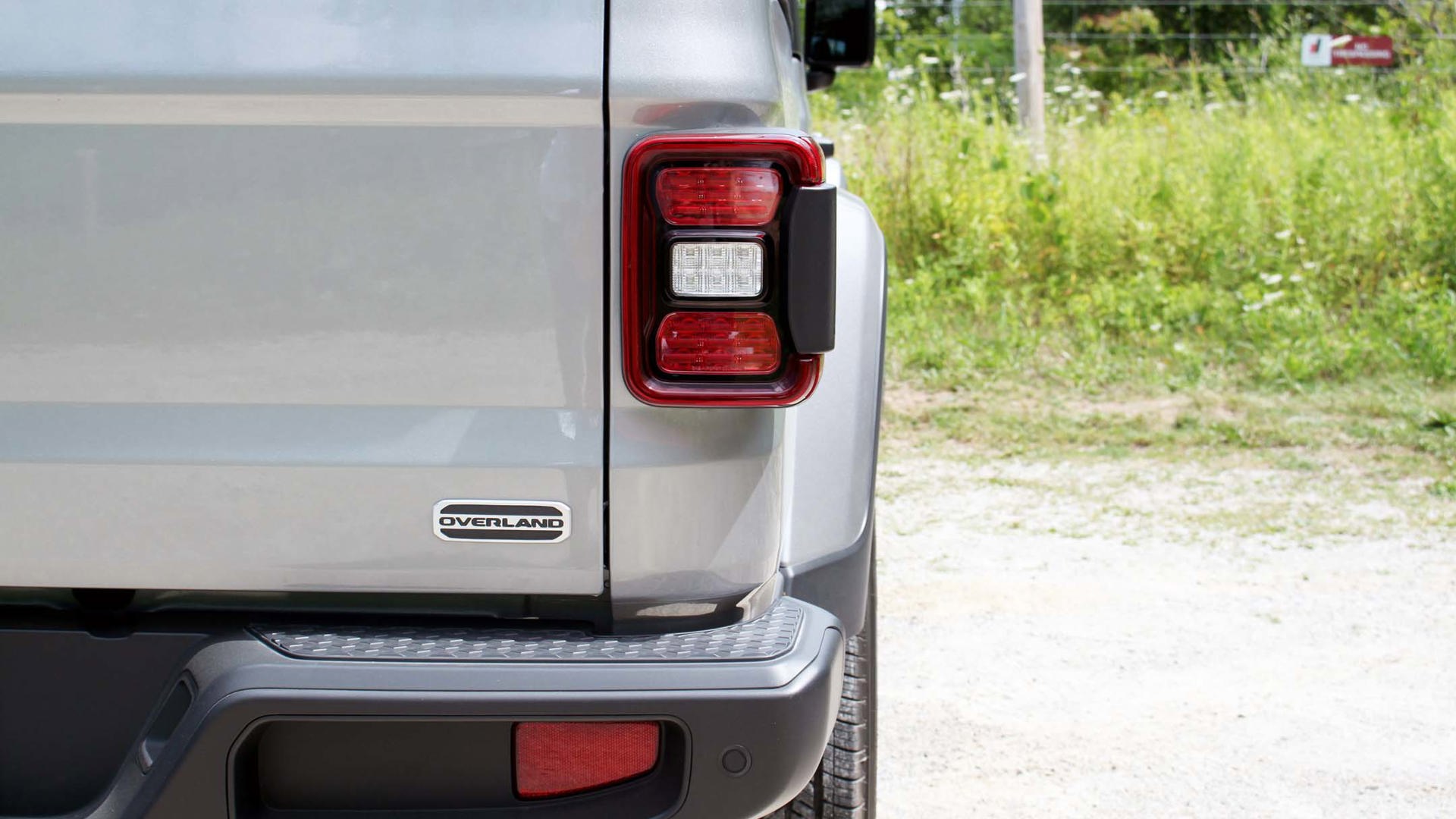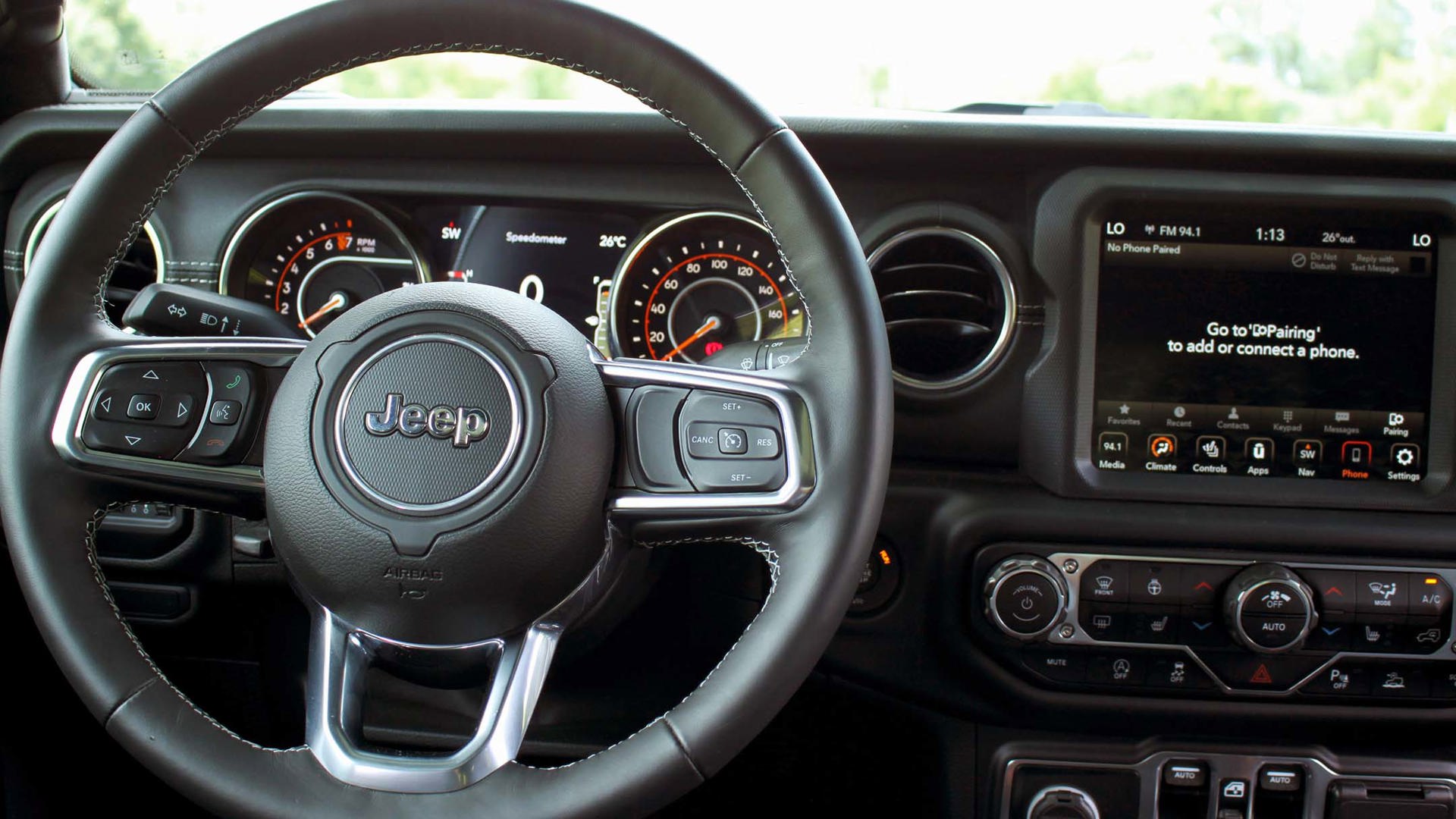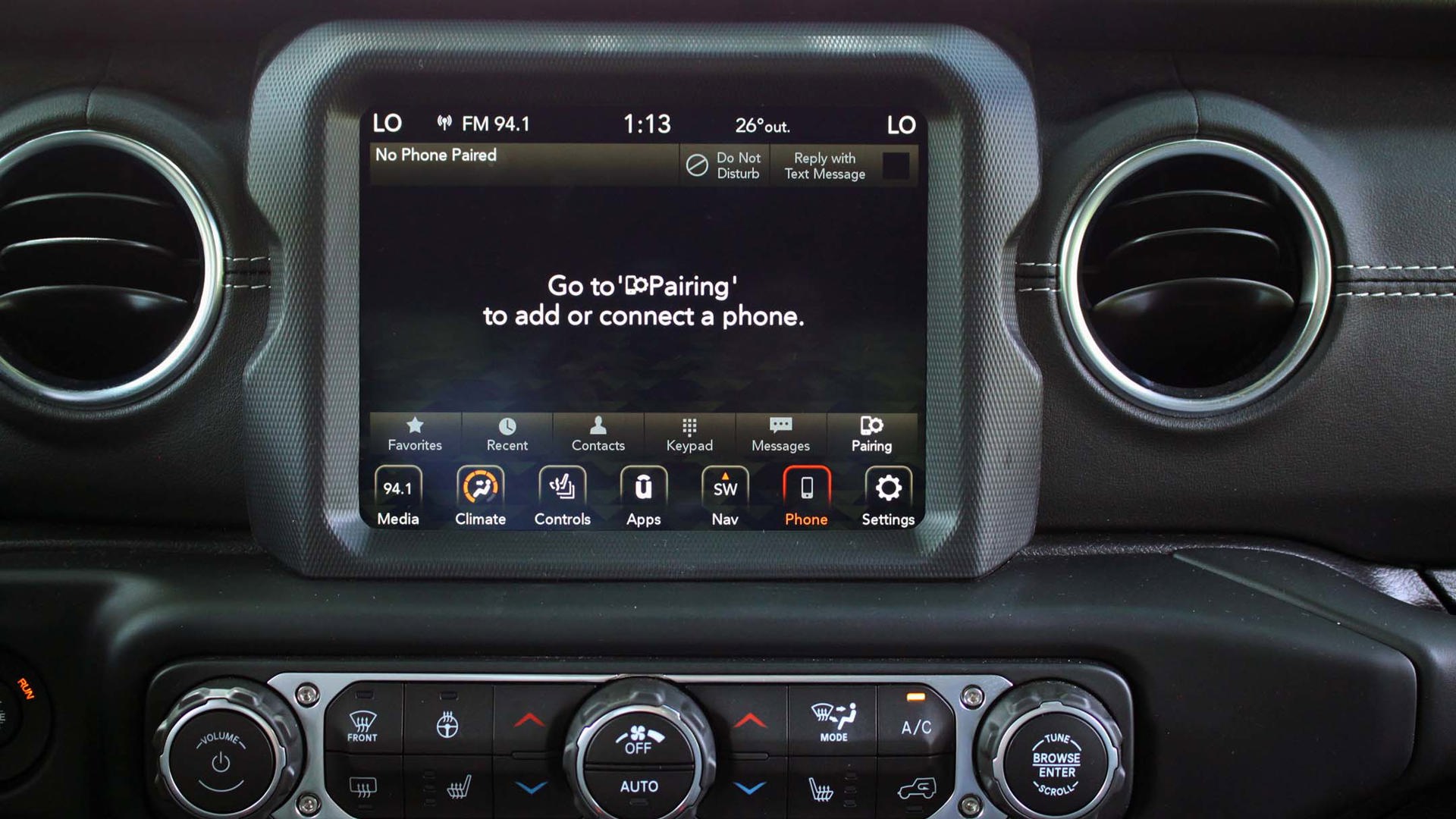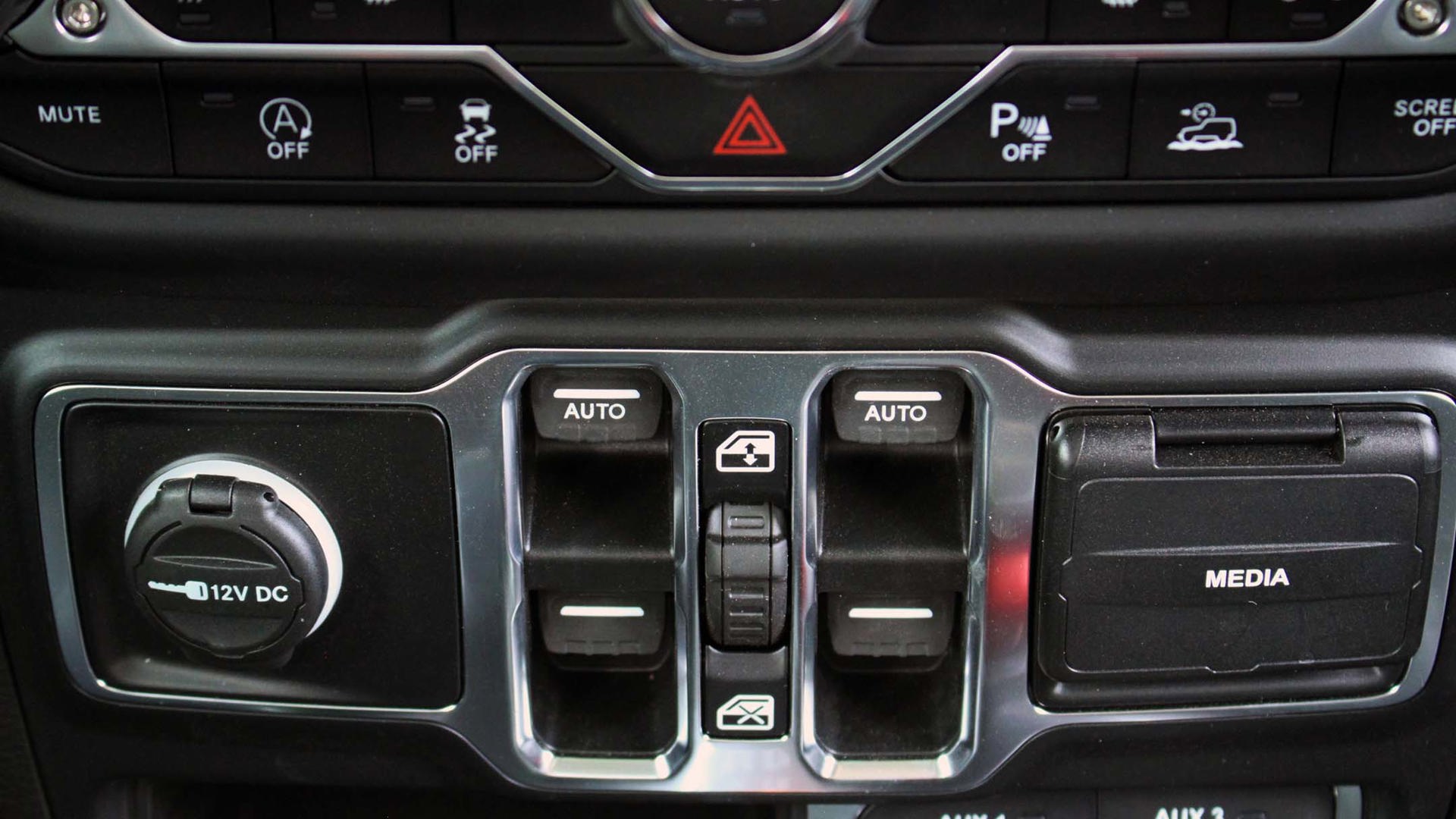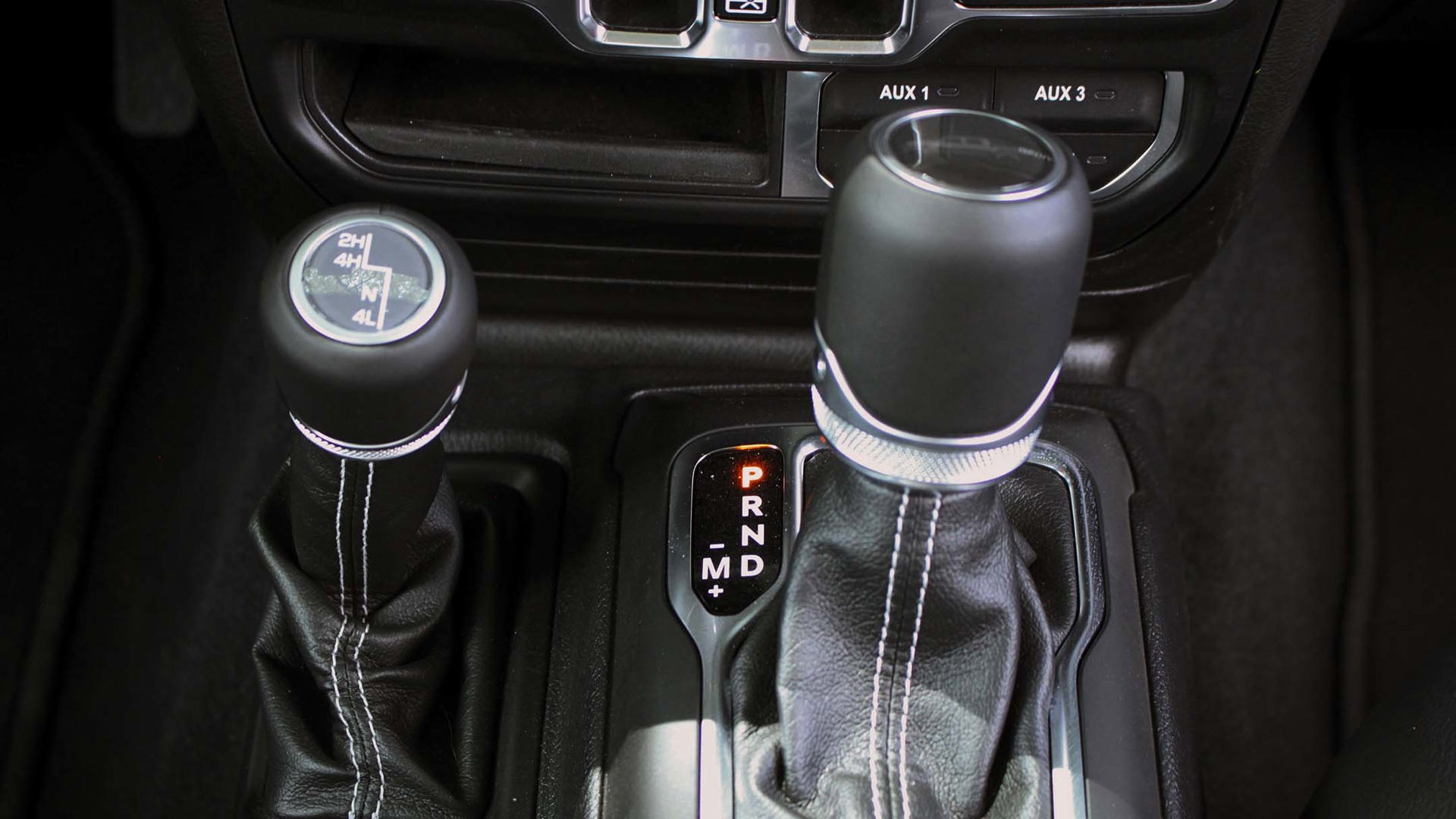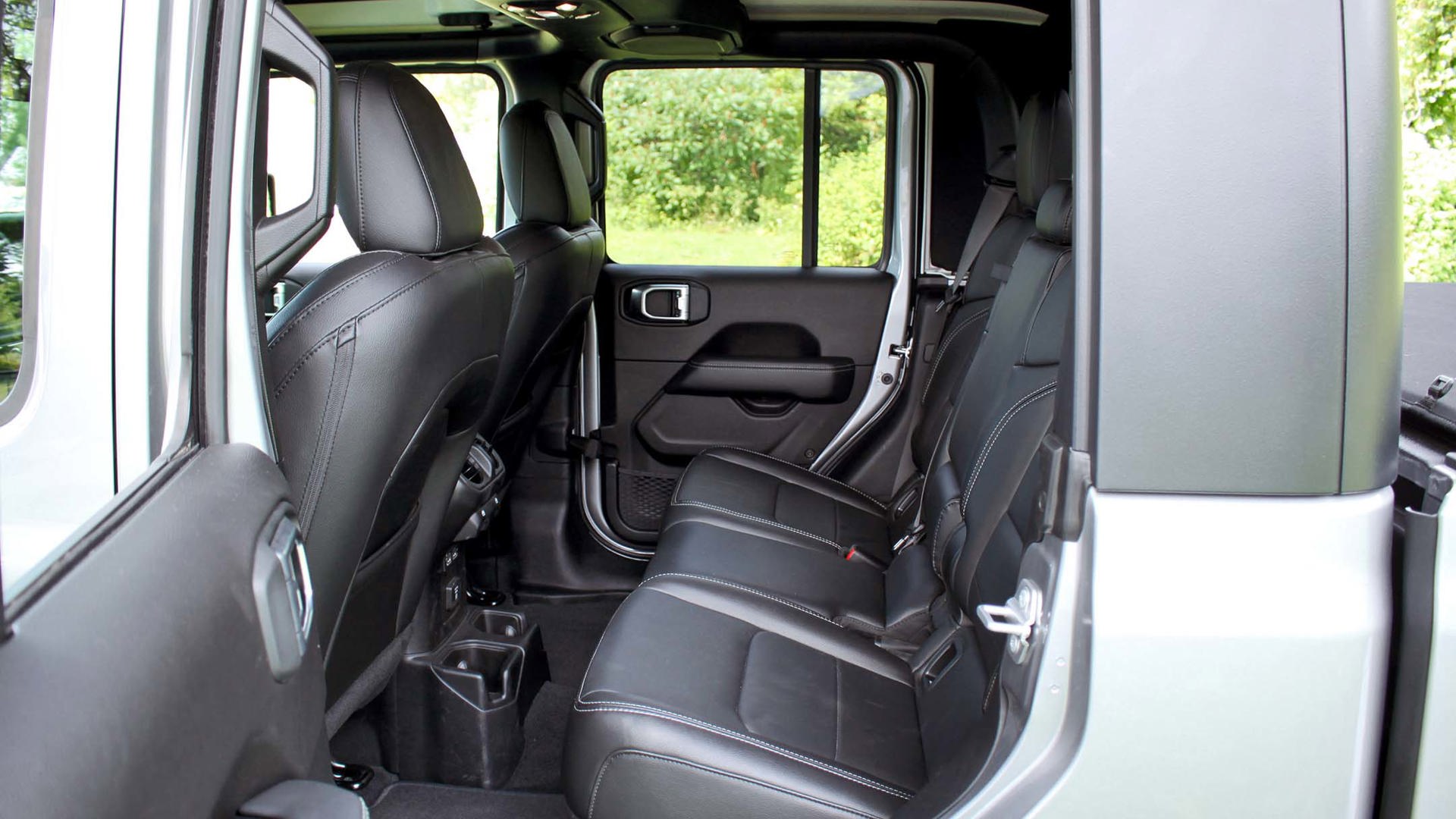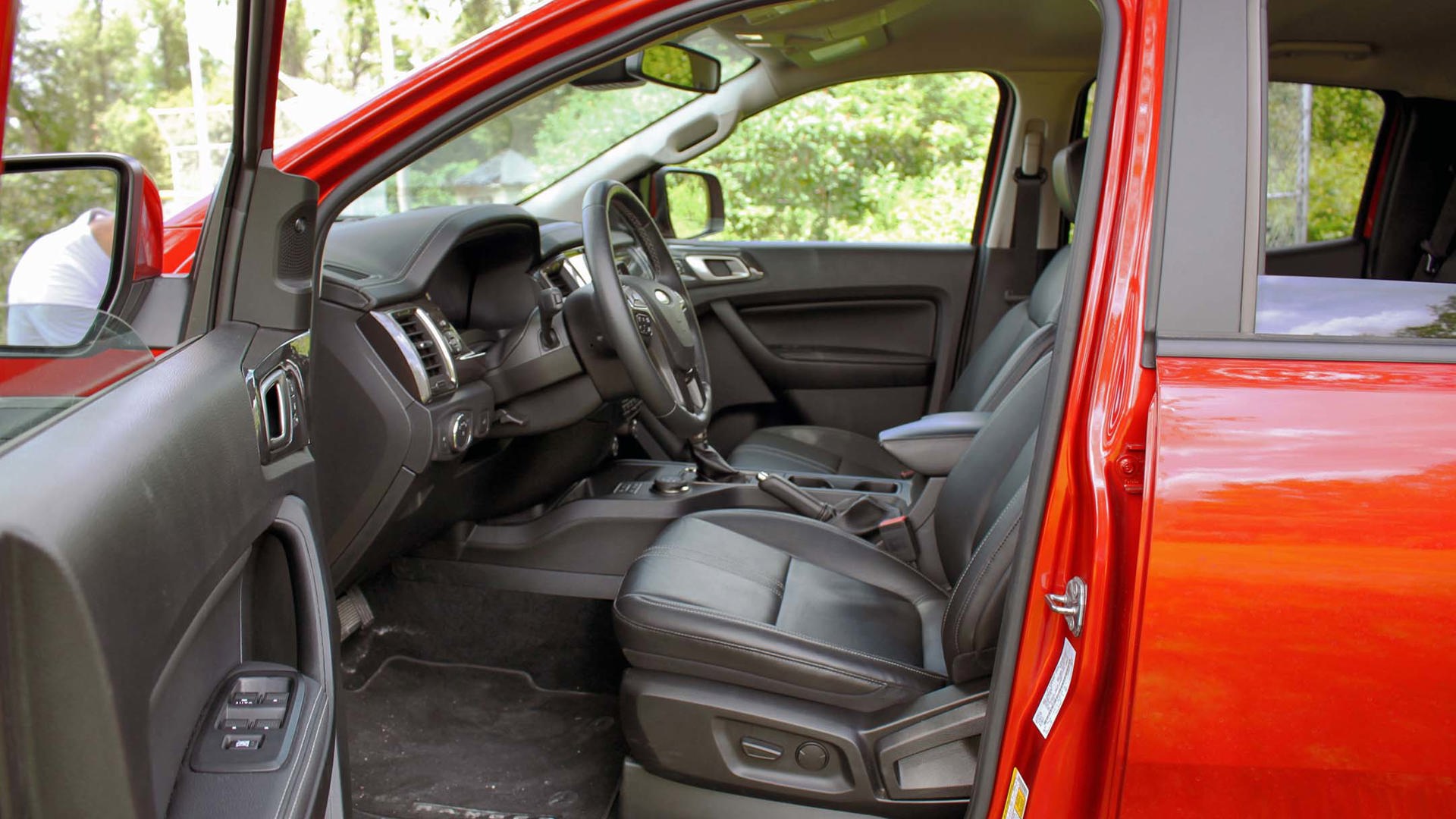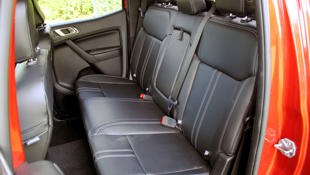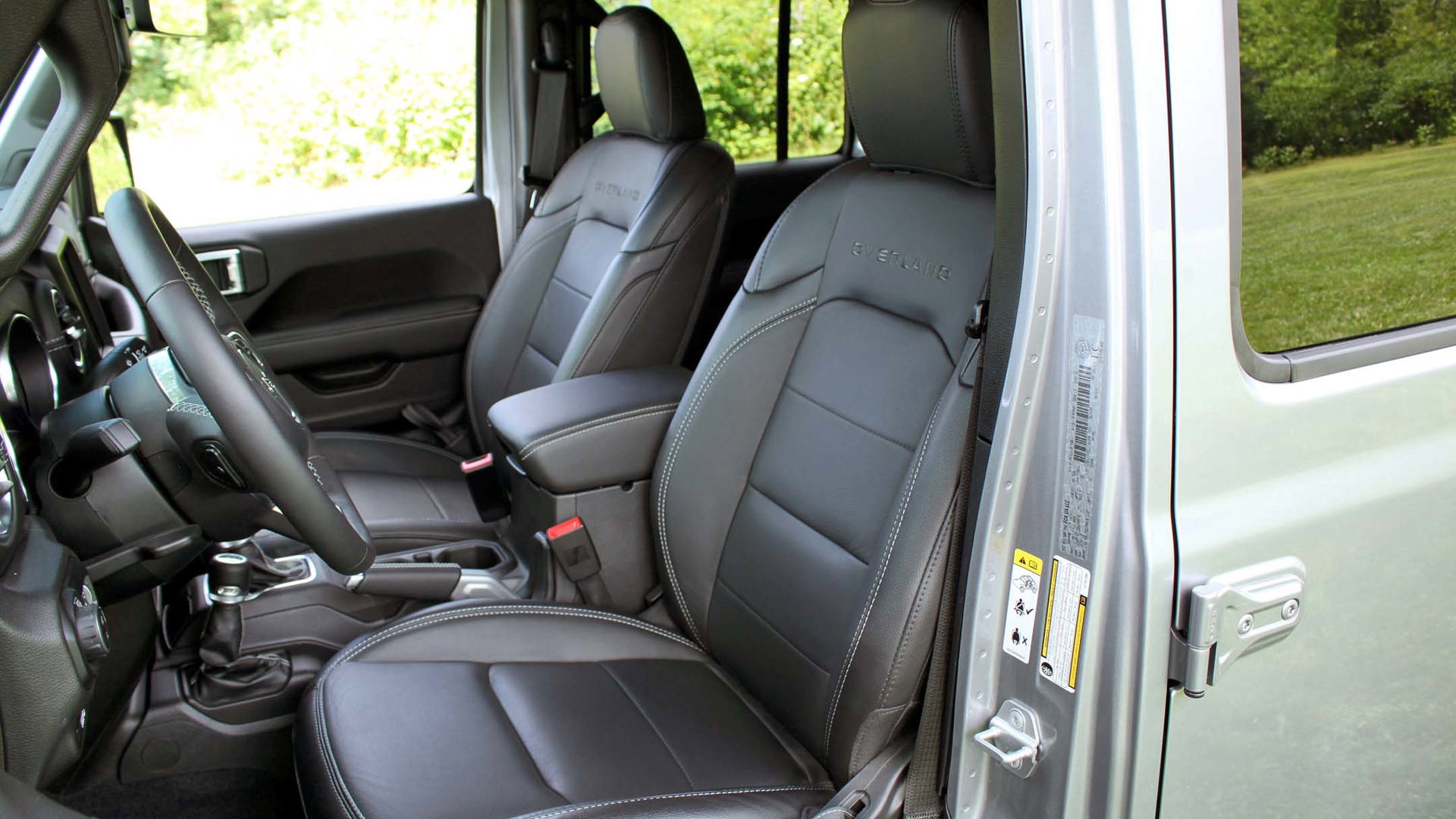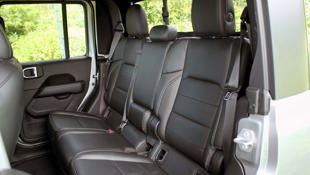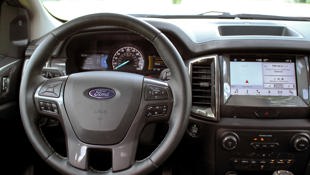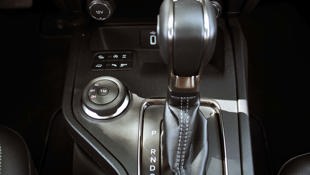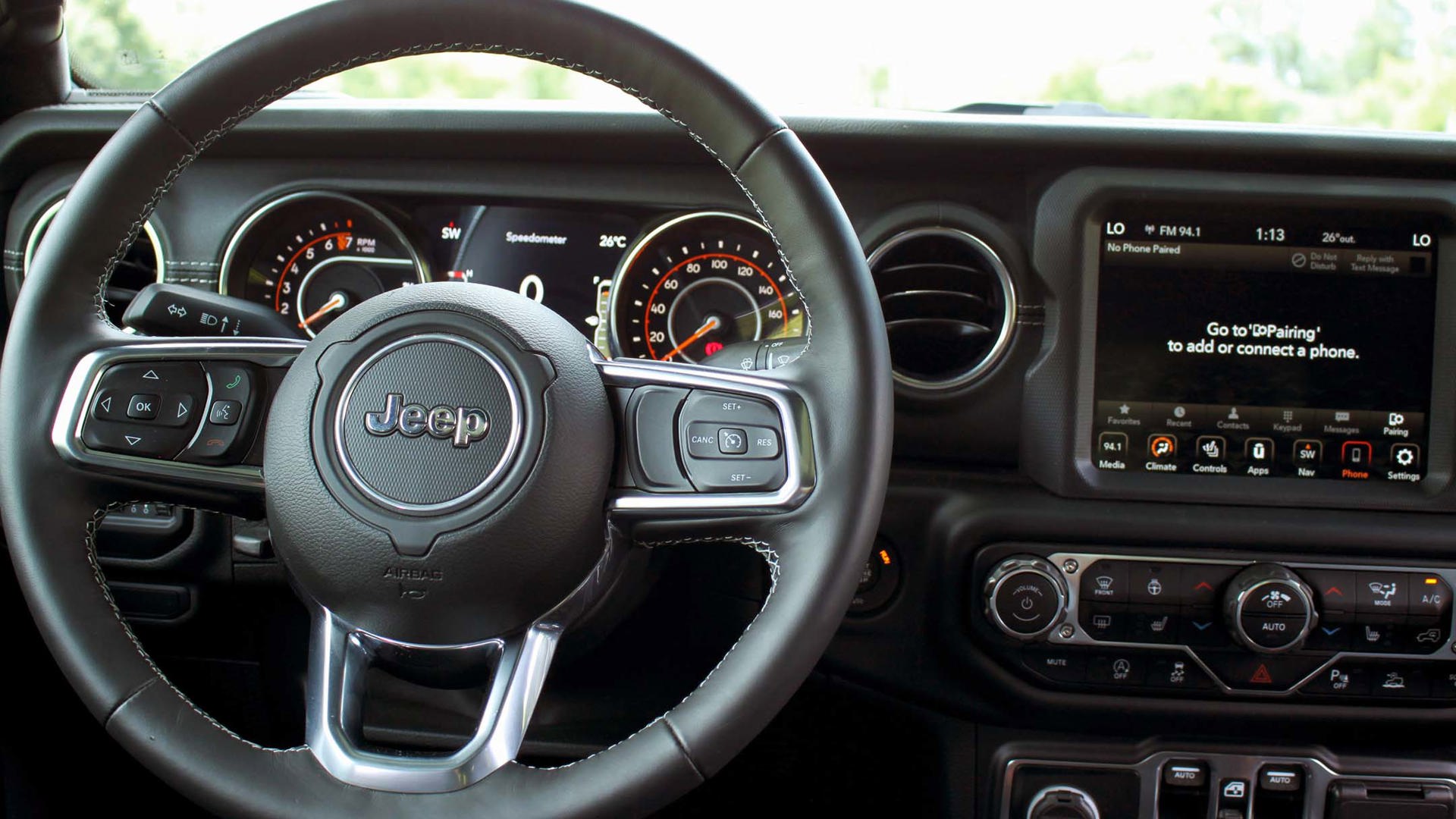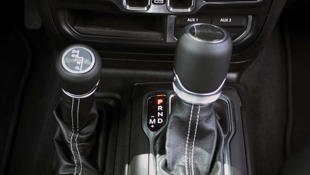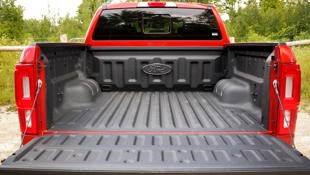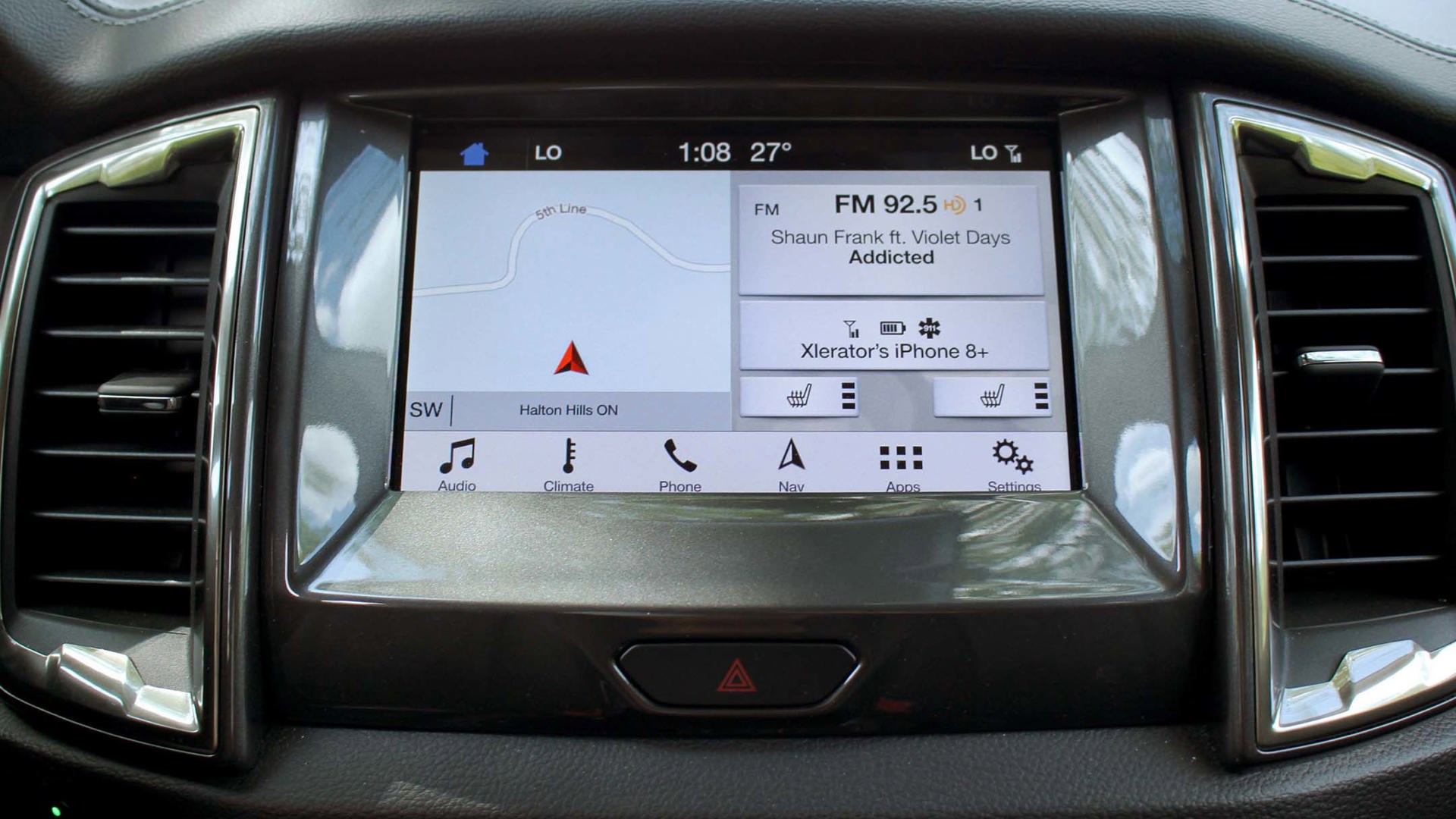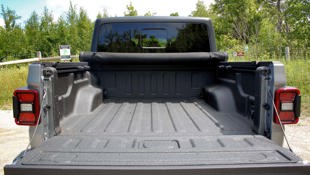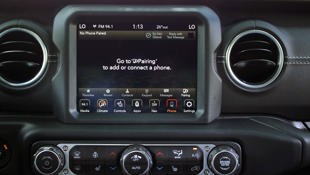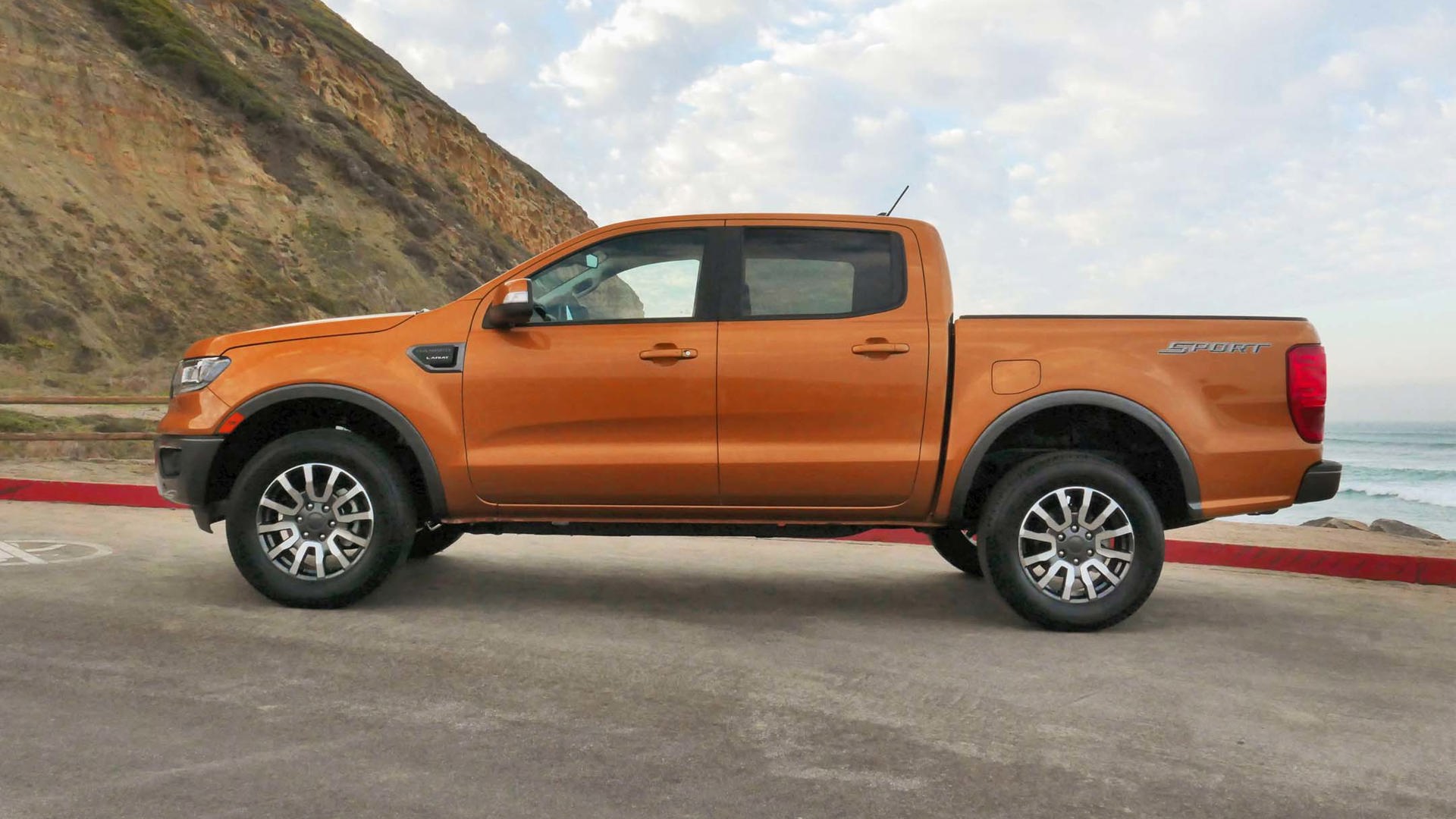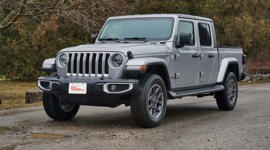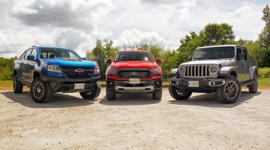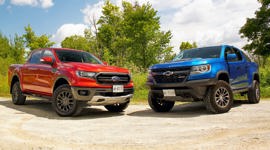Comparison Data
|
2019 Ford Ranger Lariat
|
2020 Jeep Gladiator Overland
|
|---|---|
|
Engine Displacement
2.3L
|
3.6L
|
|
Engine Cylinders
I4
|
V6
|
|
Peak Horsepower
270 hp @ 5,500 rpm
|
285 hp @ 6,400 rpm
|
|
Peak Torque
310 lb-ft @ 3,000 rpm
|
260 lb-ft @ 4,400 rpm
|
|
Fuel Economy
11.8/9.8/10.9 L/100 km cty/hwy/cmb
|
13.7/10.7/12.3 L/100 km cty/hwy/cmb
|
|
Cargo Space
1,226 L
|
994 L
|
|
Base Price
$42,289
|
$49,495
|
|
A/C Tax
$100
|
$100
|
|
Destination Fee
$1,800
|
$1,895
|
|
Price as Tested
$51,859
|
$63,235
|
|
Optional Equipment
$7,770
|
$11,745
|
The Ford Ranger and Jeep Gladiator are two new entries in the mid-size truck segment that stand in some rather significant shadows: The Ranger has to show off Ford’s trucking chops without stepping on the toes of its big brother F-150 – the best-seller that can do it all. The Gladiator, meanwhile, immediately calls to mind the Jeep Wrangler, an iconic and rugged off-roader whose capability is equal to its popularity.
The two trucks also have to prove their respective worth to buyers in a well-stocked segment. The Toyota Tacoma, Chevrolet Colorado (and twin GMC Canyon, Nissan Frontier, and even the Honda Ridgeline have been on sale for quite a while, meaning many sub-half-ton truck buyers have already spent their money.
Exterior
The Gladiator certainly stands out. No other truck looks like it, nor does any other vehicle on the road, with the exception of the Wrangler on which it’s based. Fortunately, the Wrangler’s design translates nicely to larger dimensions. The Gladiator has wider slats in the grille, but the bigger story with the exterior is just how long the truck is. Among its competitors, it’s second only to the Toyota Tacoma in terms of length and wheelbase. Compared to the Ranger, the Gladiator looks massive, but certain proportions of the Jeep look a little awkward. Somehow, in spite of the incredible size of the Gladiator, the bed can look a little small.
The Jeep has side steps to help with ingress and egress, but they’re quite cumbersome to use. The LED lights at the front and back are wonderfully bright, giving the Gladiator a unique look even at night, although you’ll be forgiven if you think its a Wrangler at first glance.
The Ranger, by comparison, is a bit generic-looking, lacking any kind of distinct aesthetic. From a distance, it can look like a Colorado or Tacoma, or even a Ridgeline, which isn’t a good situation for Ford to be in. Given the success of the F-150, why didn’t Ford just copy the design for the Ranger? The answer is that this vehicle is based on the international version of the Ranger, offered in places where the F-150 isn’t well known – or offered at all. Maybe it’s best to just call the design a bit dated, even though it’s been on our roads for barely a year.
It’s not as tall as the Gladiator, which means the Ranger is a bit more accessible, with far fewer worries about fitting in garages. Helping things out is a more appropriate height for the side steps. The Ranger also features a larger bed and shorter wheelbase, important features to be sure, but neither do much for the exterior appeal of the Ford.
Ford Ranger Exterior: 6.5
Jeep Gladiator Exterior: 7.5
Interior
Maybe you expected a utilitarian interior in the Jeep Gladiator, full of rugged hard plastics that are easy to hose off, but this Gladiator provides a very smart and spacious interior. The buttons are all well placed and easy to find, the available leather seats are comfy, and there are a few optional convenience features, including heated seats and a heated steering wheel, to go along with dual-zone climate control. Jeep drivers are also treated to a nice and informative screen in the gauge cluster. More important than all of that is the space afforded by the Gladiator – without a doubt, it’s the more comfortable of two trucks.
Jumping into the Ranger is a mix of old and new. That low-rent-looking interior you expected in the Gladiator is present here. The cabin is made of many hard, plastic materials, and even the leather seats don’t feel as plush or special as the ones in the Gladiator. It’s a far cry from the cabin you’d expect in a $50,000 vehicle, and most vehicles out there feature a better interior for half that price. At least it’s well equipped though. A slick audio system pairs well with Ford’s handy new Sync 3 infotainment system. You’ll find dual-zone climate control, heated seats, and a few helpful cubbies. Unfortunately, space and utility in the Ranger pale in comparison to that of the Gladiator.
Ford Ranger Interior: 6.5
Jeep Gladiator Interior: 7.5
Powertrain
The Gladiator is offered with one engine (for now) – a 3.6L V6 – although the automaker may be preparing a diesel powerplant for its pickup. That said, the gas-powered six-cylinder isn’t too bad, with 285 hp and 260 lb-ft of torque on tap. That’s paired with an eight-speed automatic and can be routed to the rear wheels or all four of them in either high or low range. The powertrain is designed to be fuel-efficient, with automatic engine stop-start, and a gearbox that is intent on swapping up into the highest gear available. This means that the Gladiator can feel a bit sluggish, although that may have more to do with the overwhelming size of the truck than the powertrain. You’ll feel the power off the line, and the Gladiator can get up to speed when called upon, but it never seems particularly pleased to do so.
The Ranger sports more modern gear under the hood, with a 2.3L EcoBoost four-cylinder engine. With 270 horsepower, this turbocharged setup delivers a bit less power, but much more torque, with 310 lb-ft which peaks at 3,000 rpm. The transmission has ten gear ratios to pick from and makes the most of its range: If you call upon the engine, the Ranger will find the right gear to give you its best. Like the Gladiator, the Ford has a four-wheel drive system with high and low ranges, but the system can – and should – be driven in rear-wheel drive for most occasions. Automatic engine stop-start helps the Ranger save fuel, but equally important is the fact that it has less weight to throw around than the Jeep.
Ford Ranger Powertrain: 8
Jeep Gladiator Powertrain: 7
Utility
The Gladiator is intended to be adventurous and practical, so let’s first investigate the latter part of that equation. With a max tow rating of 7,650 lb (when properly equipped), the Gladiator appears to be ideal for those who have other outdoorsy toys like ATVs, dirt bikes, or boats to drag from place to place. It can haul a hearty amount as well, with a maximum payload of 1,600 lb, depending on trim. This Overland tester has slightly lower limits, but it’s not a huge difference. What limits the Gladiator is the bed. It’s a bit small, with a total volume of about 994 litres. The cabin has cubbies and storage areas to help you find a home for your stuff, but trucks are meant to be used, and with such a small bed, the Gladiator seems a bit lost here.
The Ranger is the better choice here when it comes to doing typical truck stuff. Sure, it has a slightly lower maximum tow rating of 7,500 lb. But the Ford features a much higher maximum payload of 1,860 lb, and has a larger bed, even with the short box. SuperCrew models boast 1,226 L in box capacity, and buyers who opt for the SuperCab get even more cargo space. While the Gladiator can tow a tiny bit more, the Ranger has it beat in both box space and payload, making it the better truck in a traditional sense.
Ford Ranger Utility: 8
Jeep Gladiator Utility: 7
Driving
The Gladiator feels awkward on the road, with some of the worst handling characteristics we’ve encountered in a modern truck. It has vague steering and wafts like a boat when changing lanes or cornering. The hood also dives steeply every time you brake and lifts when you hit the throttle. In case it isn’t clear, the Gladiator isn’t refined at all on the road.
Some drivers may find these characteristics to be endearing, as they’re part of the charm of a Jeep, but even the Wrangler doesn’t feel this clumsy on the road. In case you were wondering, the Gladiator features the same heavy-duty Dana 44 axles front and rear, the same hardware used on the top-dog Wrangler Rubicon. That explains some of its rocky behaviours, as the Gladiator seems overbuilt in order to go where the path isn’t paved.
Naturally, all that whining on-road turns to confidence off-road. The Gladiator will soak up bumps with ease, and it has some incredible approach and departure angles at 40.8 and 25 degrees respectively. The Jeep will also bring out the adventurer in you thanks to its 254 mm ground clearance. Where the Gladiator stumbles is its 18.4-degree breakover angle, a by-product of its long wheelbase.
The Ranger feels better suited for the road, with sharper responses, especially from the steering, which may be a bit light, but feels excellent in comparison to the Gladiator’s. While the Jeep is floaty and unresponsive, the Ranger feels a bit bumpy, and the cabin is a bit louder in the Ford. The suspension, while less rugged than the Gladiator, is better-rounded, offering decent road feel while maintaining some off-road capability.
The FX4 Off-Road Package equips the Ranger with an electronic locking rear differential, more underbody protection, and monotube shocks for better support off-road, as well as a terrain management system that sorts out the traction and stability controls for different surface conditions. As off-road-ready as Ford claims it to be, the Ranger falls behind in terms of approach angle, with just 28.7 degrees to work with, although the departure angle of 25.4 degrees is on par with the Jeep and the break-over angle is much better at 21.5 degrees. All that is accomplished with a lesser ground clearance of 226 mm.
Ford Ranger Driving: 7
Jeep Gladiator Driving: 7
Fuel Efficiency
Trucks aren’t typically known for their thrifty mindset, but these smaller trucks deliver some surprising fuel economy – at least in comparison to their half-ton counterparts and relative to their capabilities. The Jeep Gladiator is rated at 13.7 / 10.7 / 12.3 L/100 km city / highway / combined, according to Natural Resources Canada (NRCan). On a quick rural test loop, the Jeep surprised us by delivering 11.5 L/100 km combined.
The Ranger has an obvious advantage thanks to its smaller engine and lower weight. The folks at NRCan have rated the Ranger’s fuel consumption at 11.8 / 9.8 / 10.9 L/100 km, city / highway / combined. Our tester showed 10.9 L/100 km on our test route, cementing its status as the more efficient of the two trucks.
Ford Ranger Fuel Economy: 8
Jeep Gladiator Fuel Economy: 7
Safety/Technology
The Gladiator makes a good first impression thanks to its bright and easy-to-read screens in the centre console and gauge cluster. The UConnect infotainment system features Android Auto and Apple CarPlay, and even if you don’t use those systems, you’re treated to a pretty high-quality system that has navigation as well. The Gladiator has a few USB ports as well as household AC outlets in the cabin and bed, which are helpful if you take the truck camping and need some juice while enjoying the wilderness. Partying on the go? The Gladiator has a matching wireless Bluetooth speaker that fits neatly behind the rear passenger seats. At $395, it’s a pricey option.
However, there are relatively few safety and driver-assistance features on tap: a clear rear-view camera with parking sensors, blind-spot monitoring, and rear cross-traffic alert are all you’ll find.
The Ranger is far better equipped. Sure, the cabin looks a little dated, but there is the Sync 3 infotainment system. It’s a bit smaller than the Jeep’s system at 8.0 inches instead of 8.4, but it has the same smartphone compatibility and is easy to use. The Ranger also features a helpful amount of USB ports and a 110-volt AC outlet. Beyond that, it has several smart safety features. There’s a forward-collision warning system with automatic braking, blind-spot monitoring, trailer sway control, adaptive cruise control, and a rearview camera. The Ranger has been tested by the Insurance Institute of Highway Safety (IIHS) but failed to win a Top Safety Pick award as there are some concerns in the small overlap crash test. The Gladiator has yet to be tested.
Ford Ranger Safety/Technology: 7
Jeep Gladiator Safety/Technology: 6
Value/Quality
Those in the market for a small truck are looking for something more affordable than a half-ton truck, yet both of these vehicles are surprisingly expensive. That can be due to the long list of options on high-trim vehicles, but asking over sixty grand for a Gladiator seems like a stretch. All in, the Gladiator Overland model we had cost $63,235, and it isn’t even the top-trim version of the truck. Buyers who want a truly off-road-ready model will spend more on the Rubicon. At least the Gladiator comes with an attractive interior, but it’s missing some of the luxuries you’d expect in a vehicle that costs this much.
The Ranger is a bit more affordable at $51,859, but that still seems like a steep asking price – especially with its dated cabin design. Fortunately, there are a few more safety features in the Ford to show that your money is going somewhere worthwhile. The Ranger is also more practical, has more torque, and has better fuel economy to keep running costs down. If you’re buying a truck with value in mind, the Ford is the better pick of these two.
Ford Ranger Value/Quality: 7
Jeep Gladiator Value/Quality: 5
The Verdict
Neither of these trucks is overly impressive, but they have their upsides. The Gladiator has a rugged personality that it exhibits everywhere. You can’t hide the Wrangler influences in its styling or driving manners. With a spacious cabin and limited bed, it seems to be a less utility-focussed truck, but it’s far too expensive and cumbersome to recommend. Those looking for a more dependable off-roader will be happy with a Wrangler. Those looking for more utility can find it in other pockets of the segment.
The Ranger takes the final score thanks to its more refined powertrain, better fuel economy, and its focus on truck-worthy utility. It can tow just as much but has a bigger bed that has a higher payload. It’s also more affordable than the Jeep. Although we’d happily recommend an F-150 for those looking for a true truck, the Ranger’s smaller size and capabilities may suit some buyers just fine.
Ford Ranger: 58/80
Jeep Gladiator: 54/80
